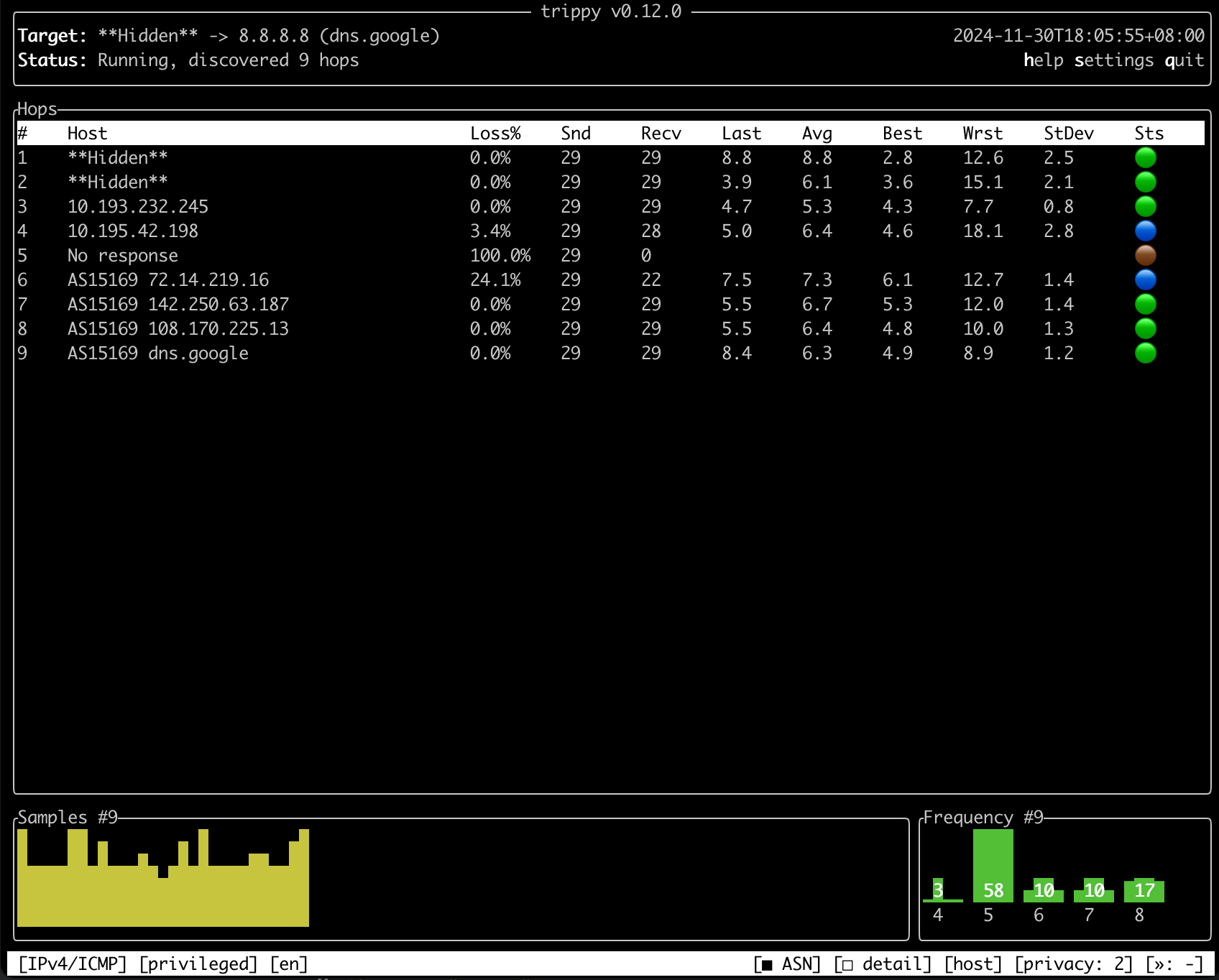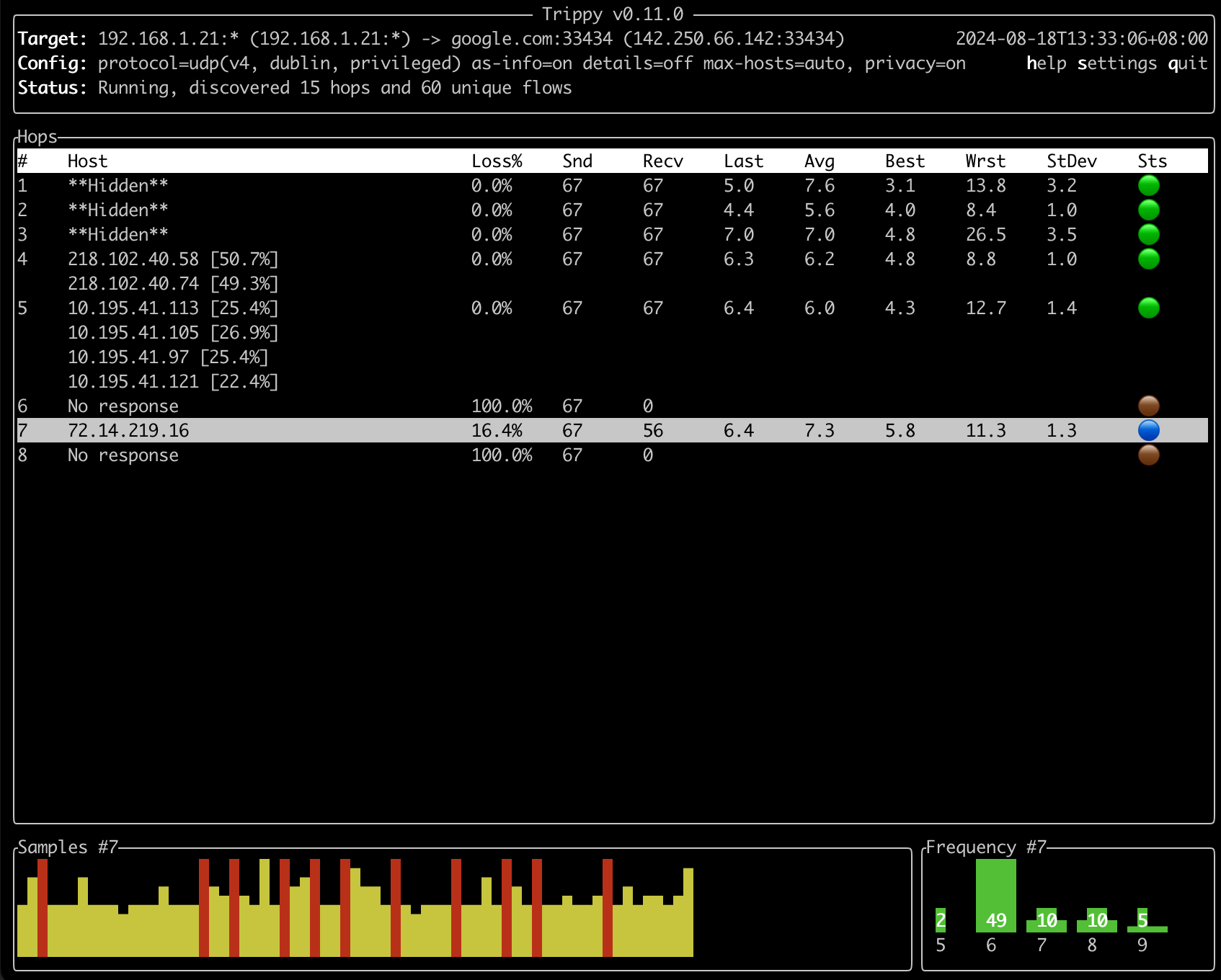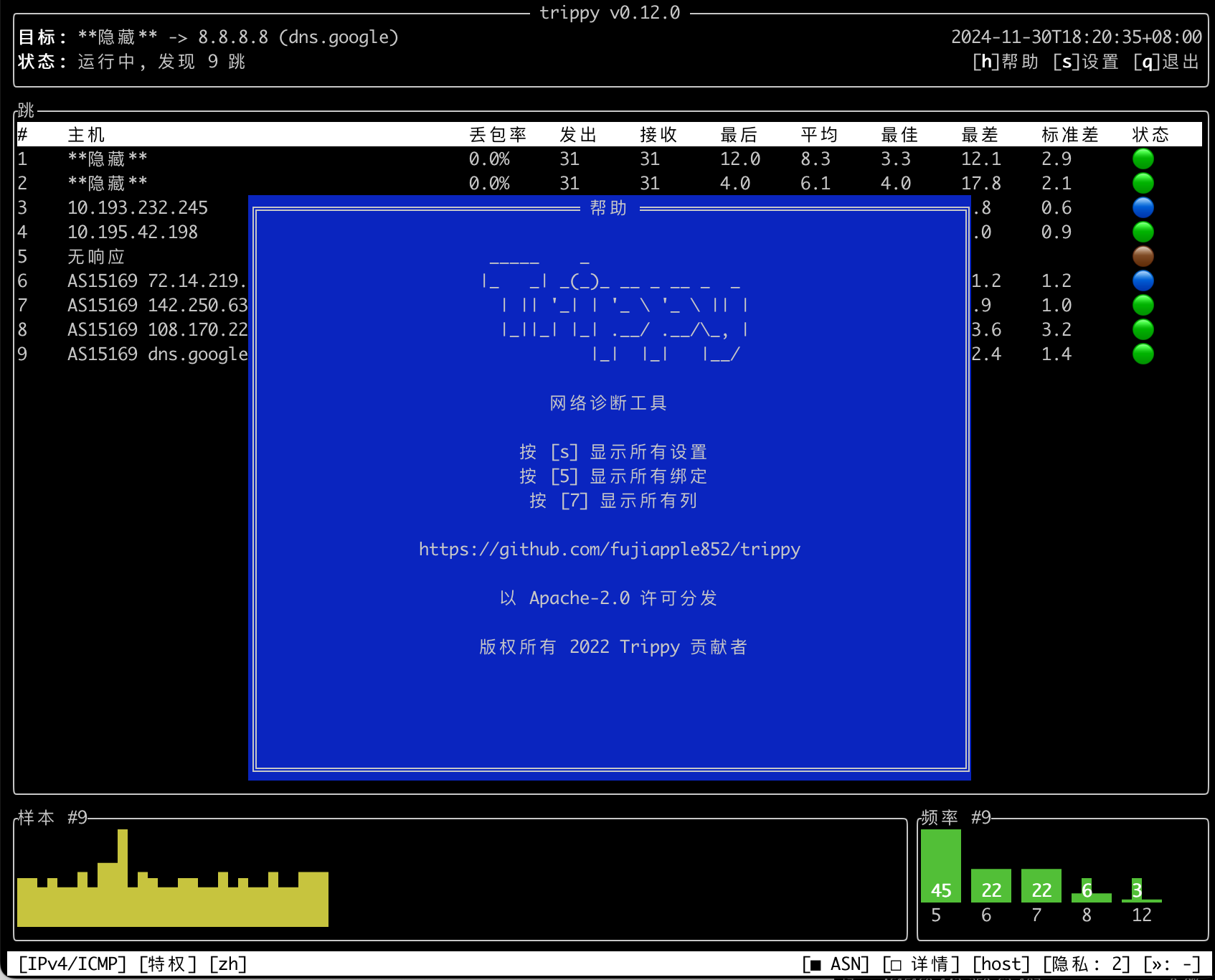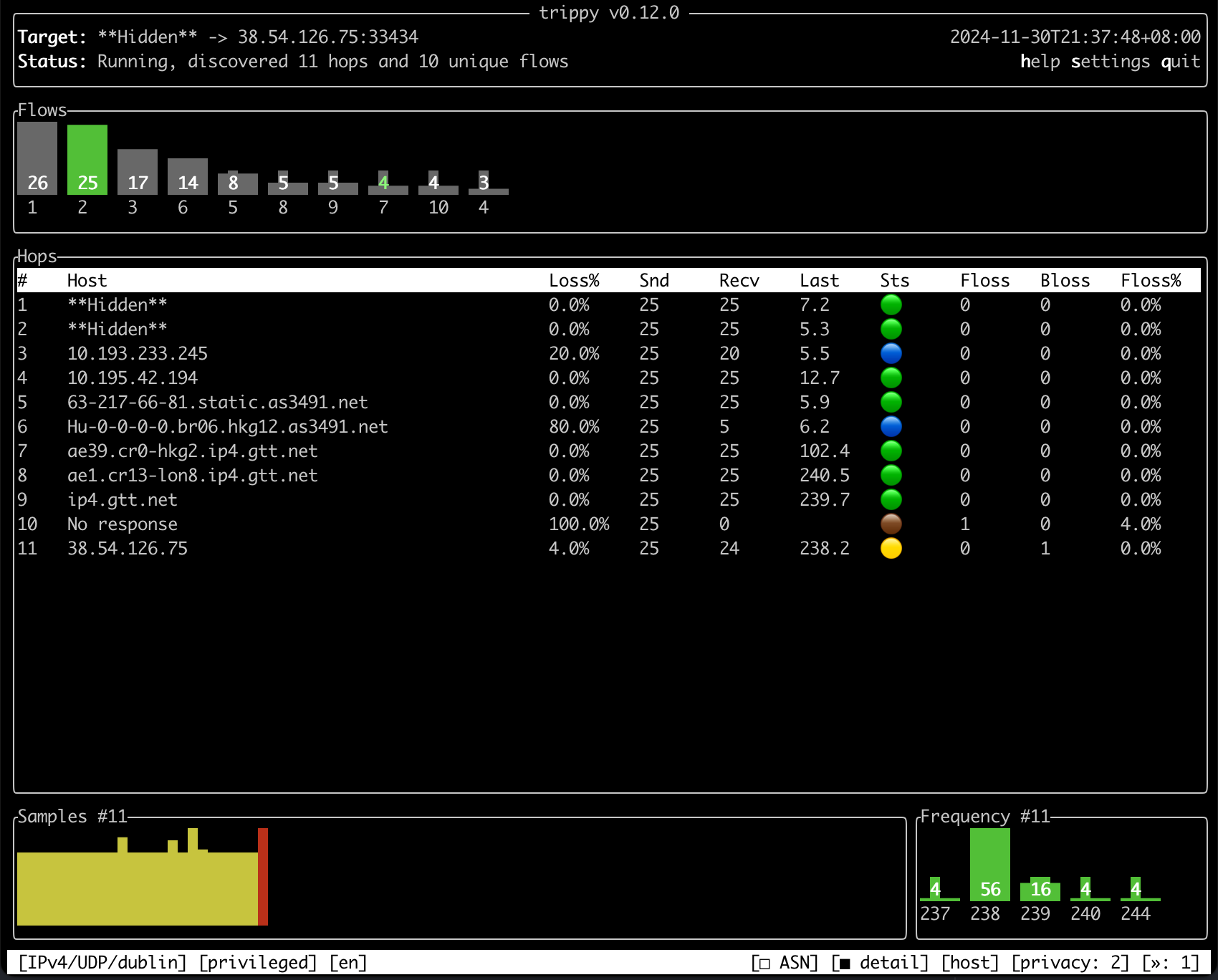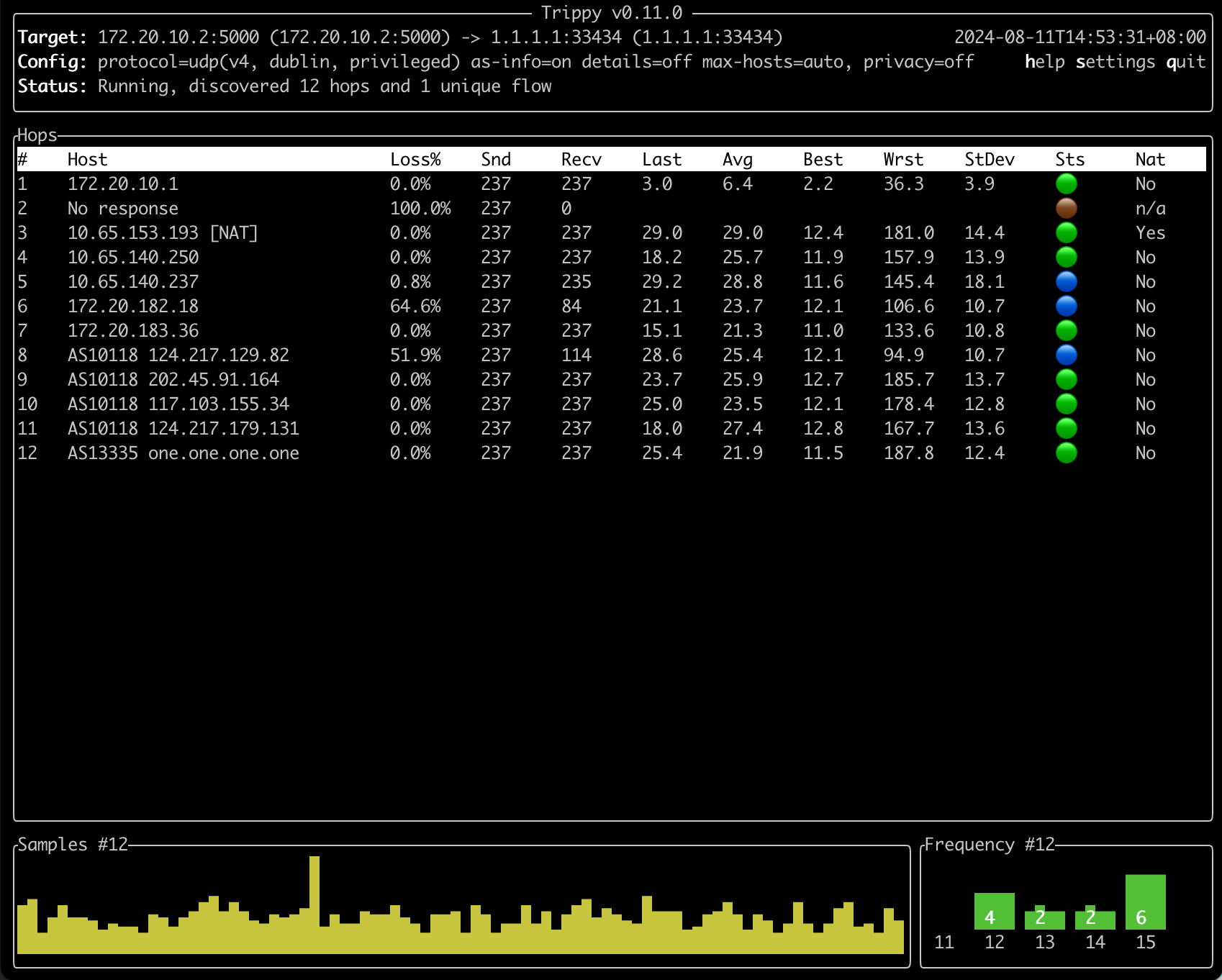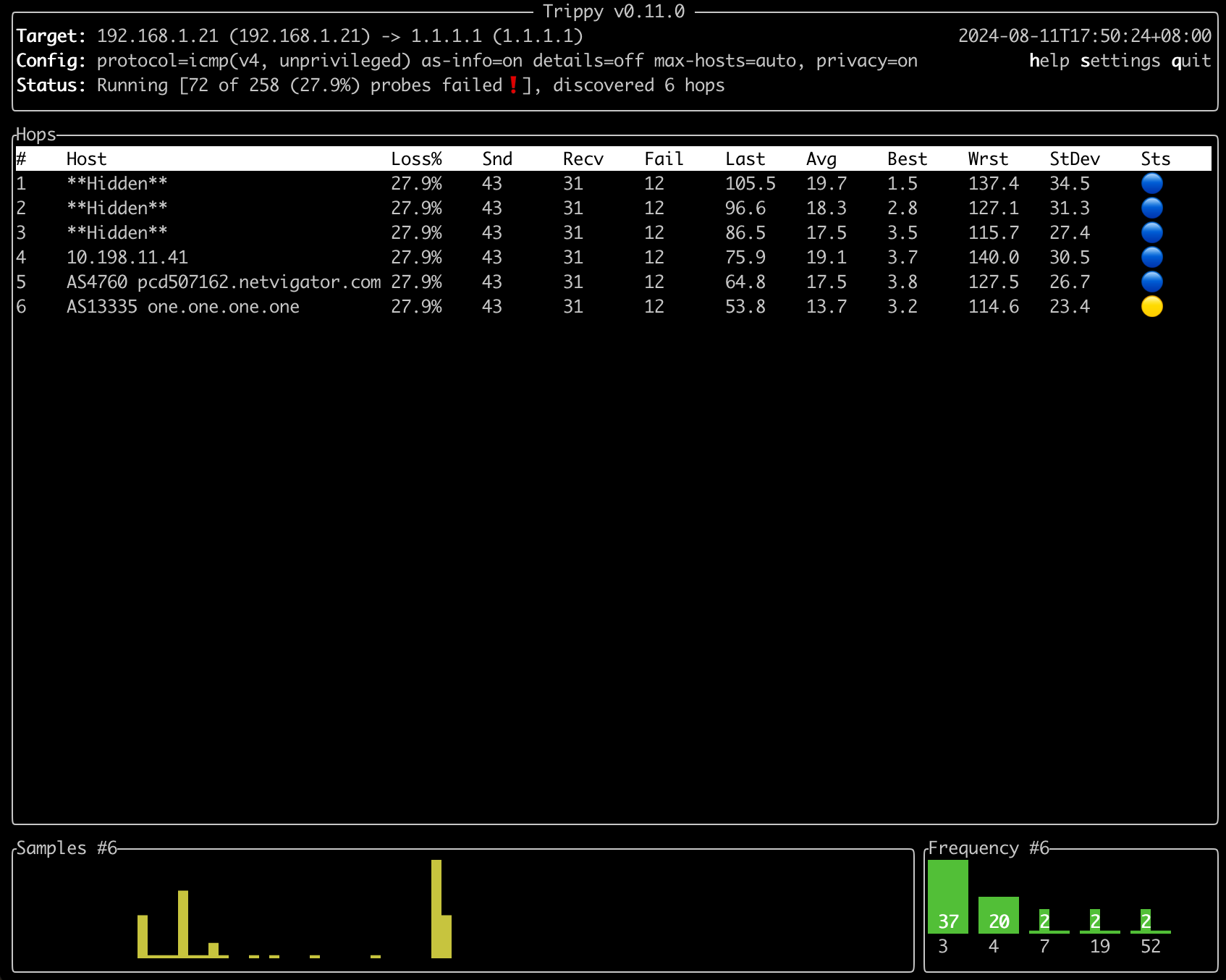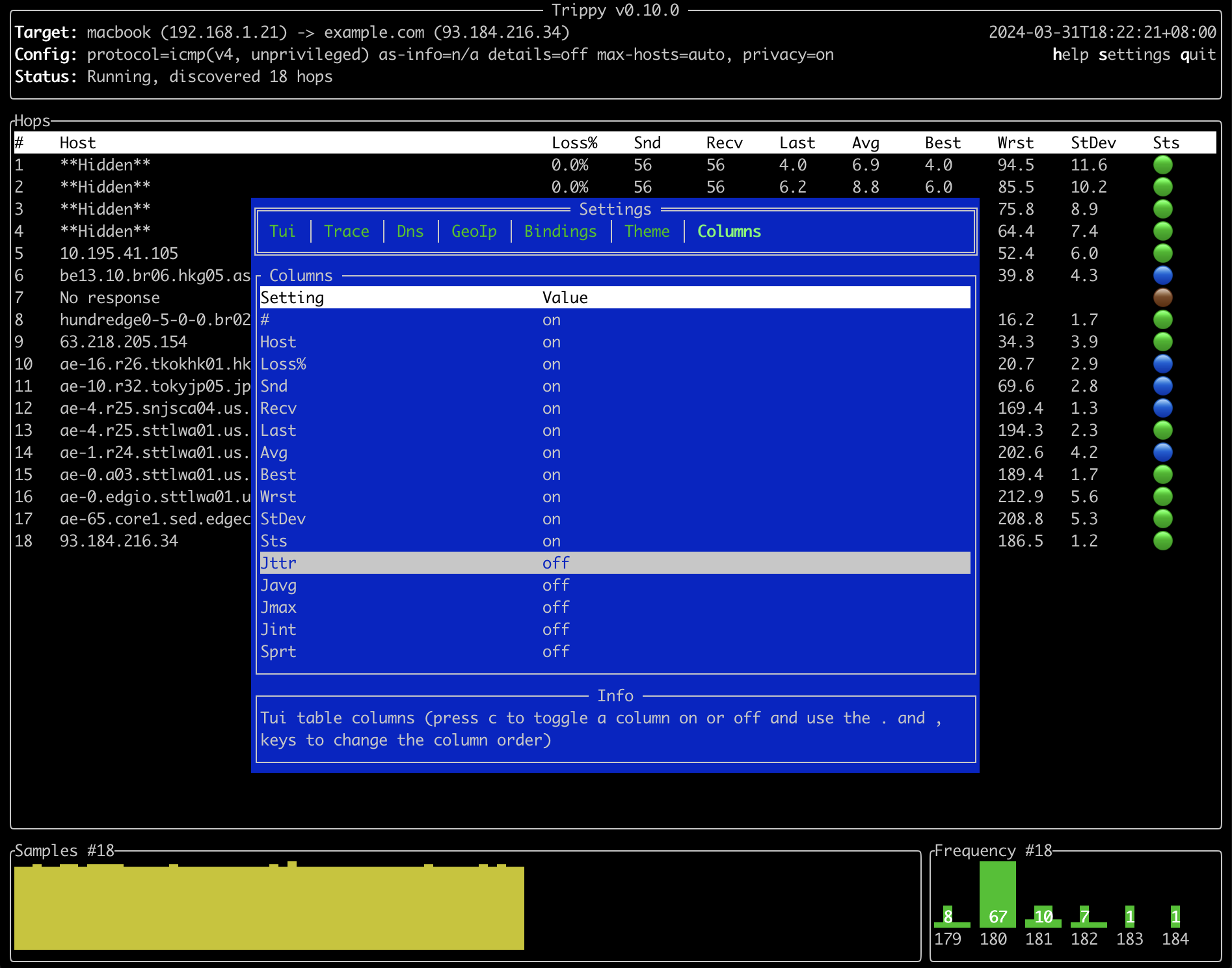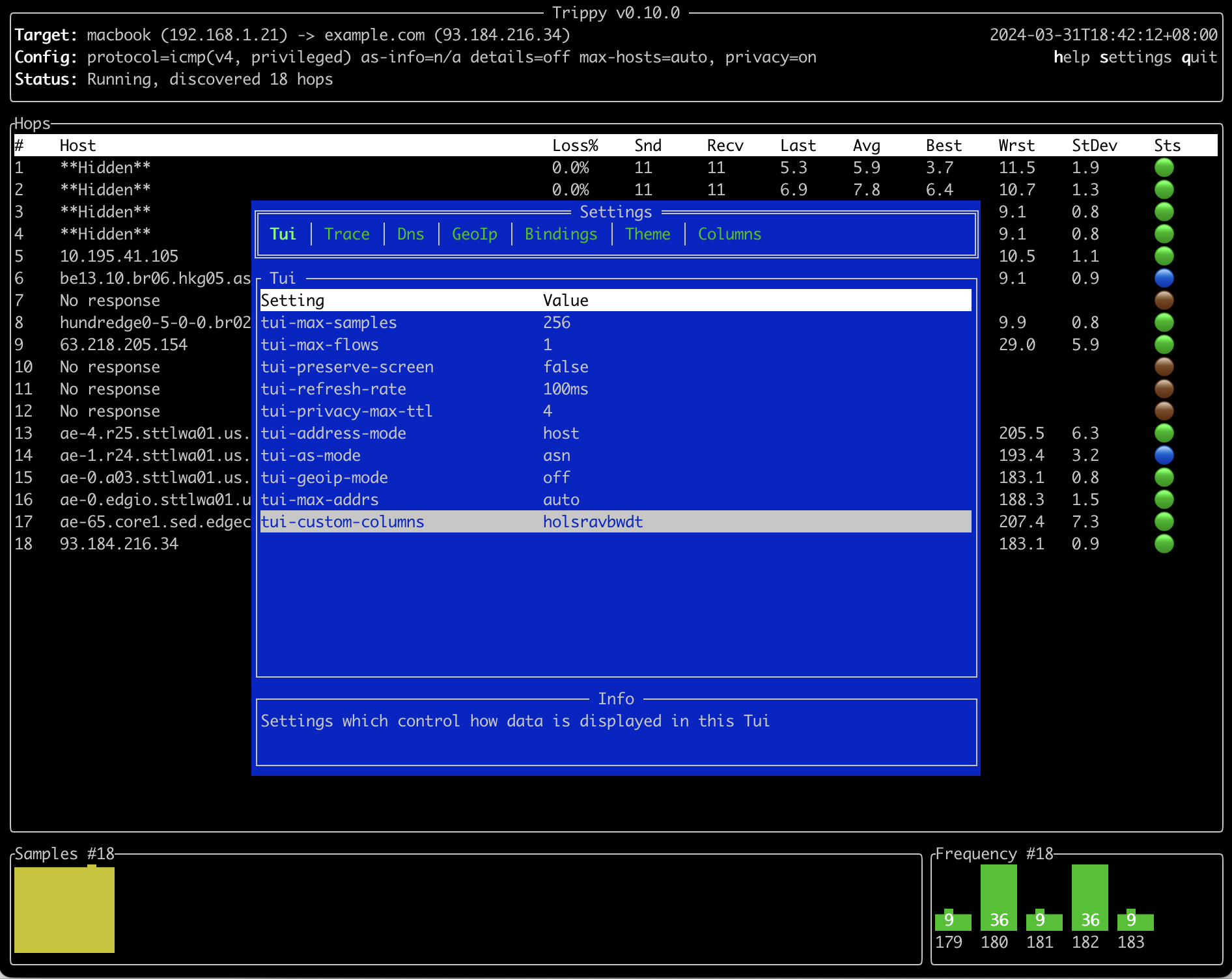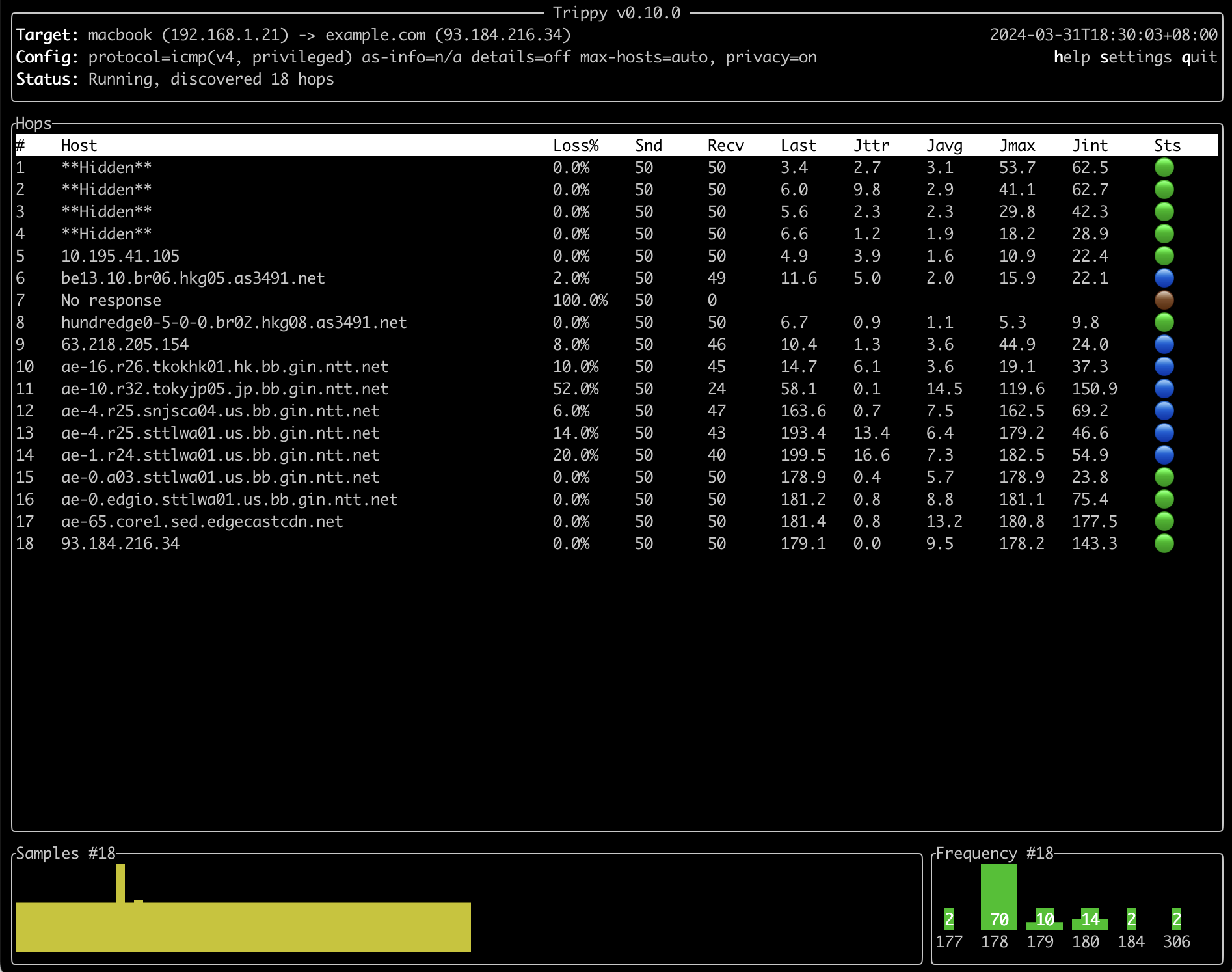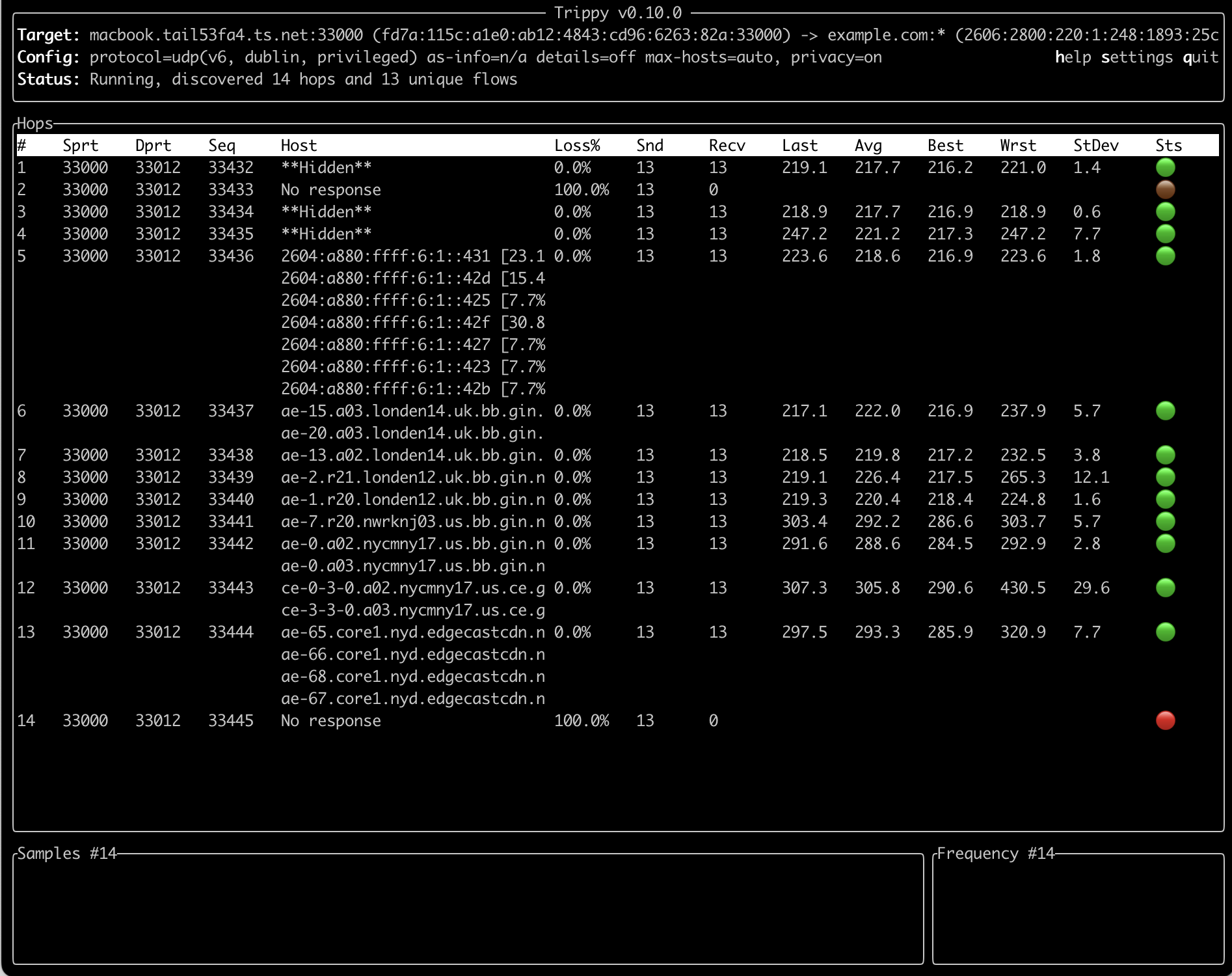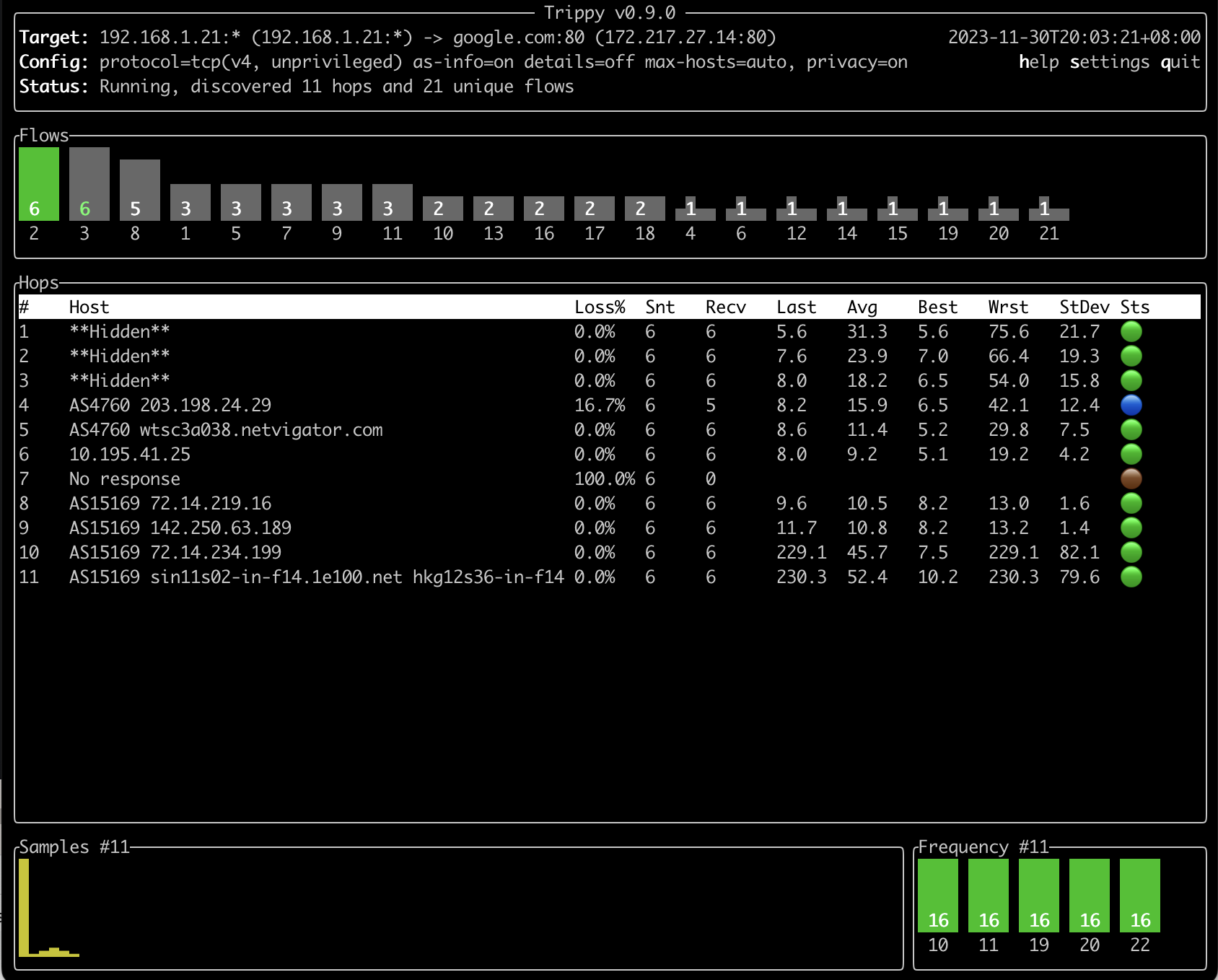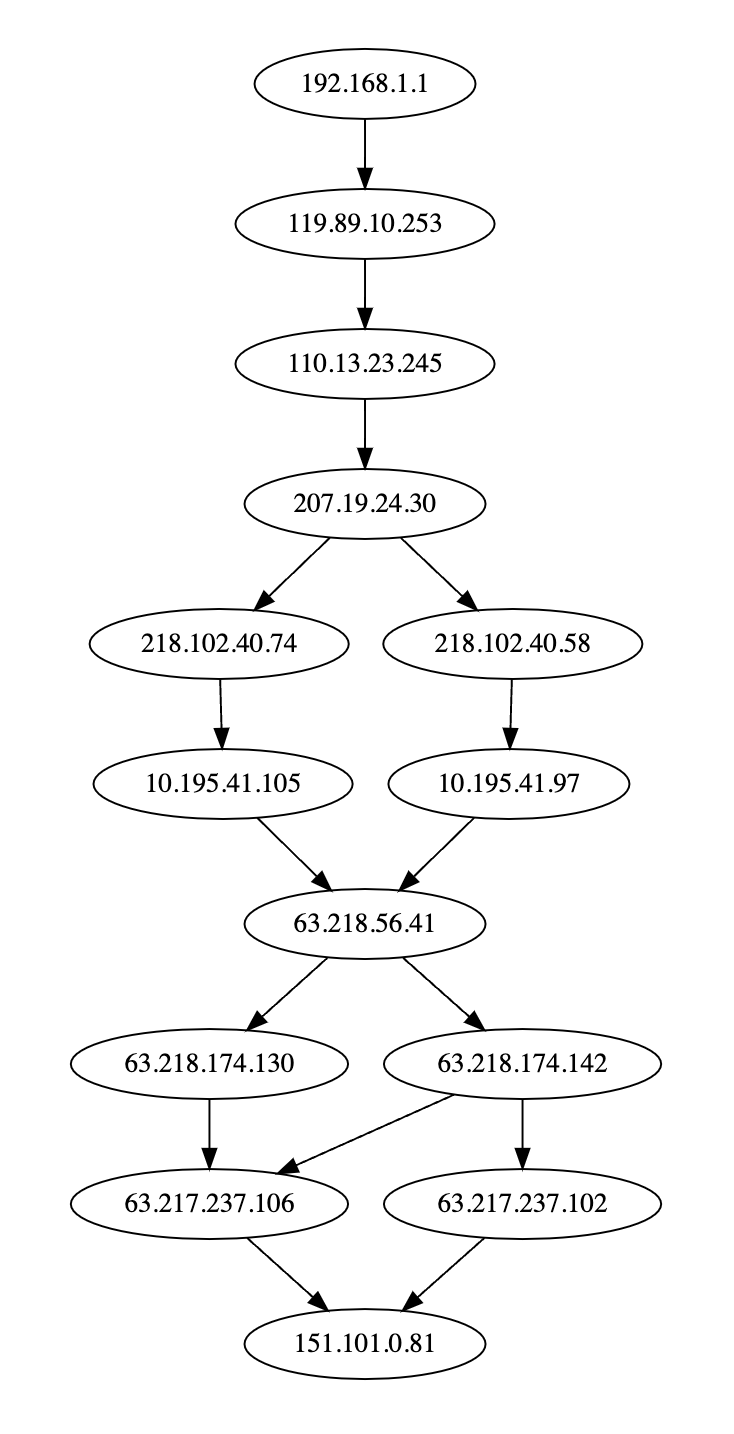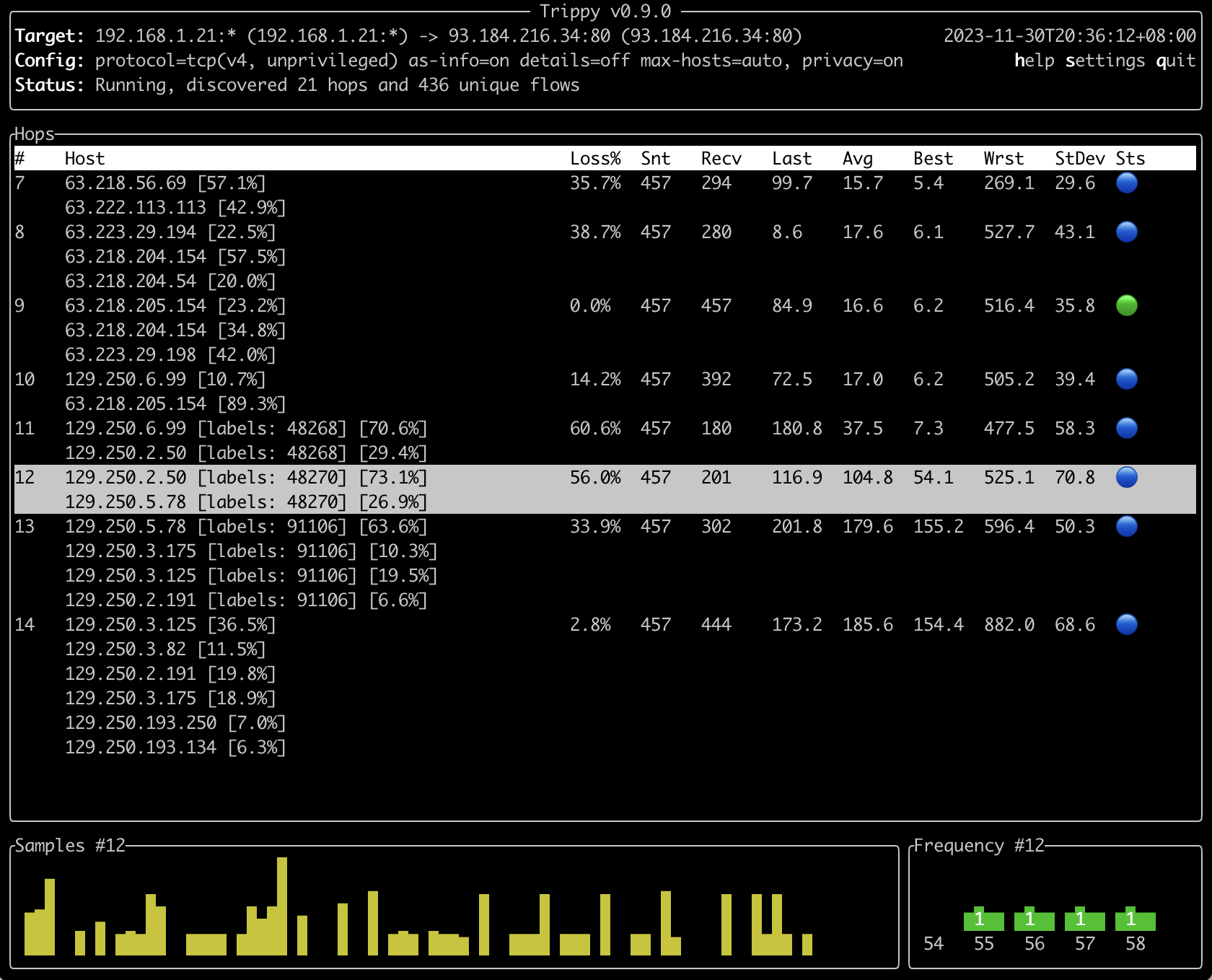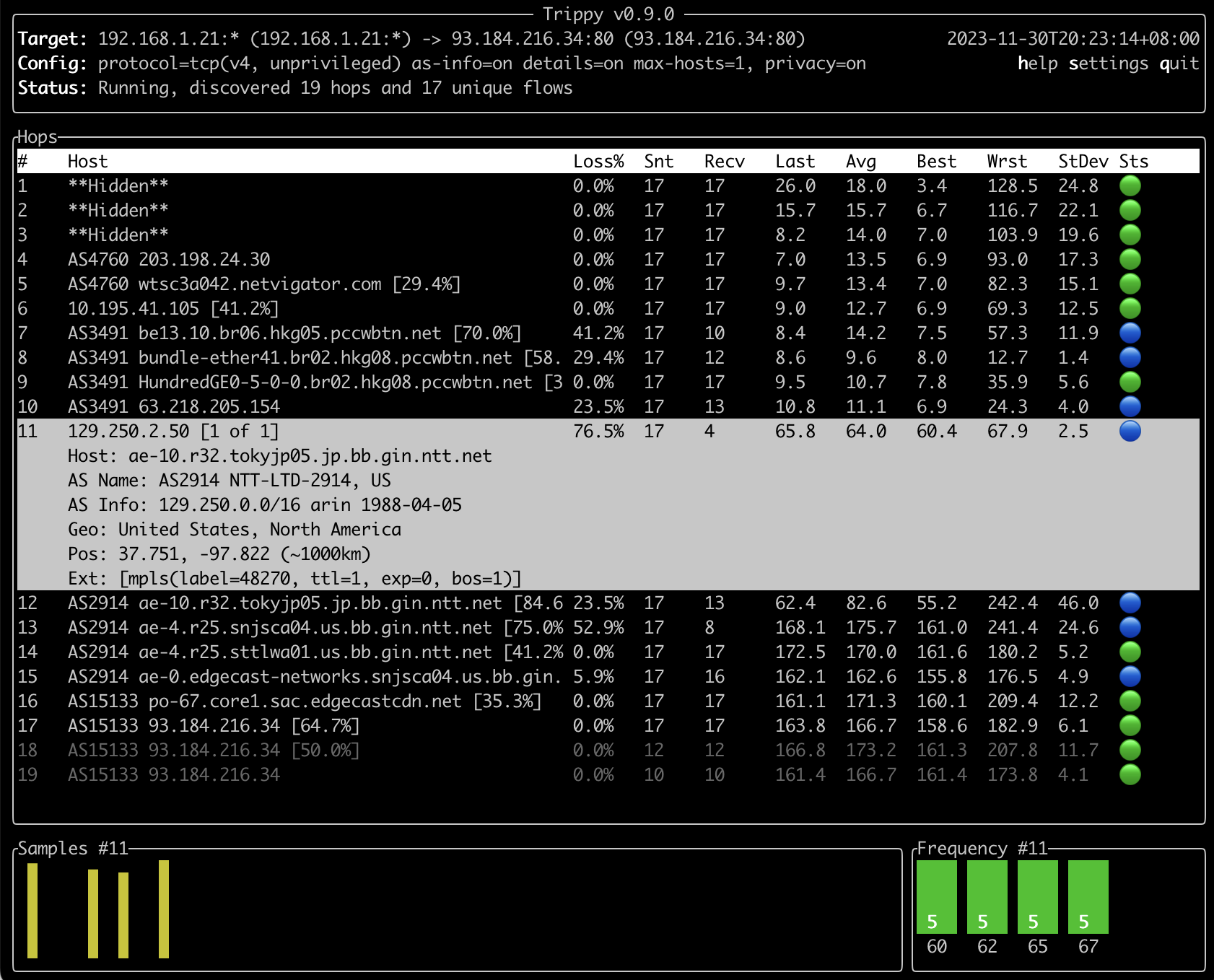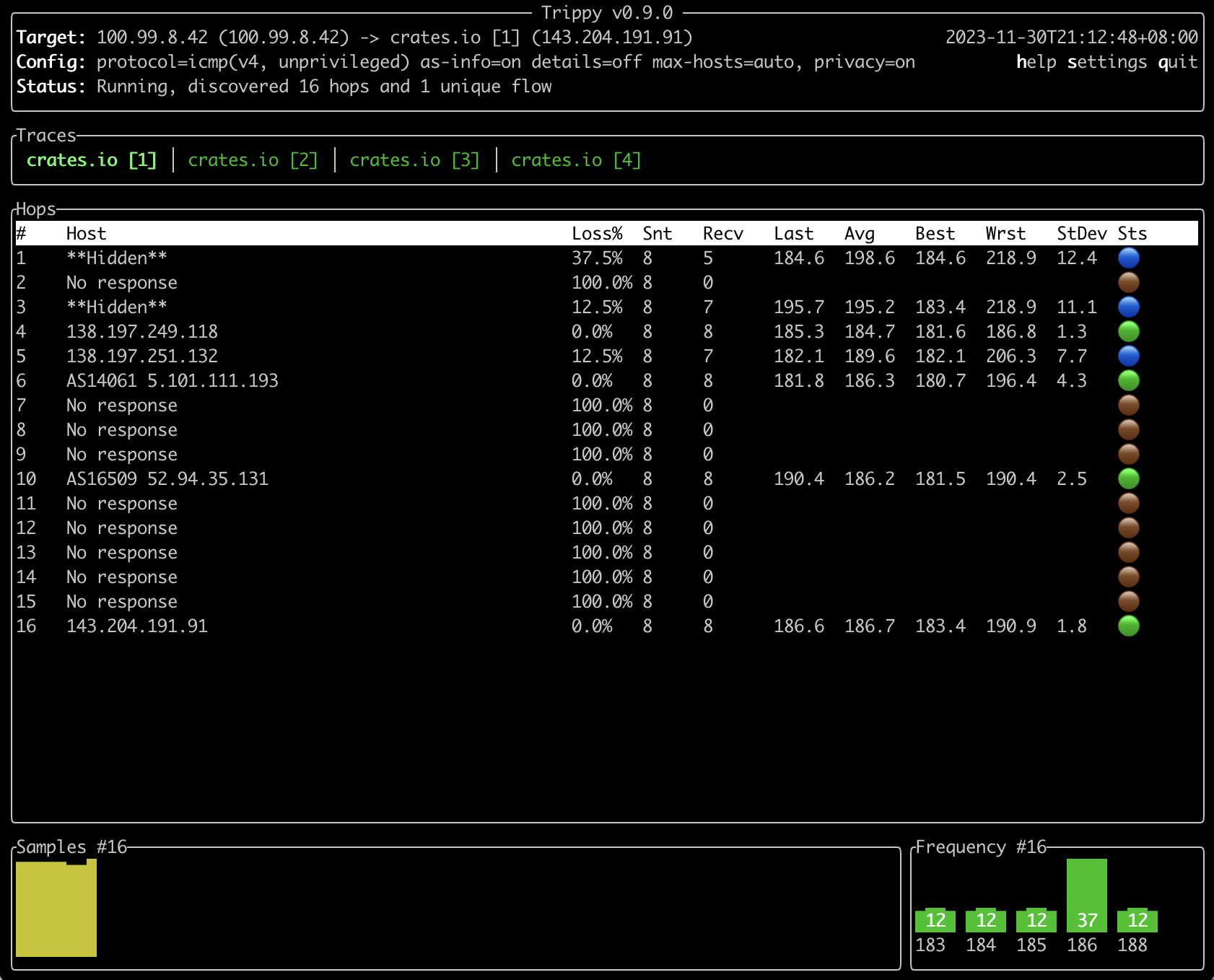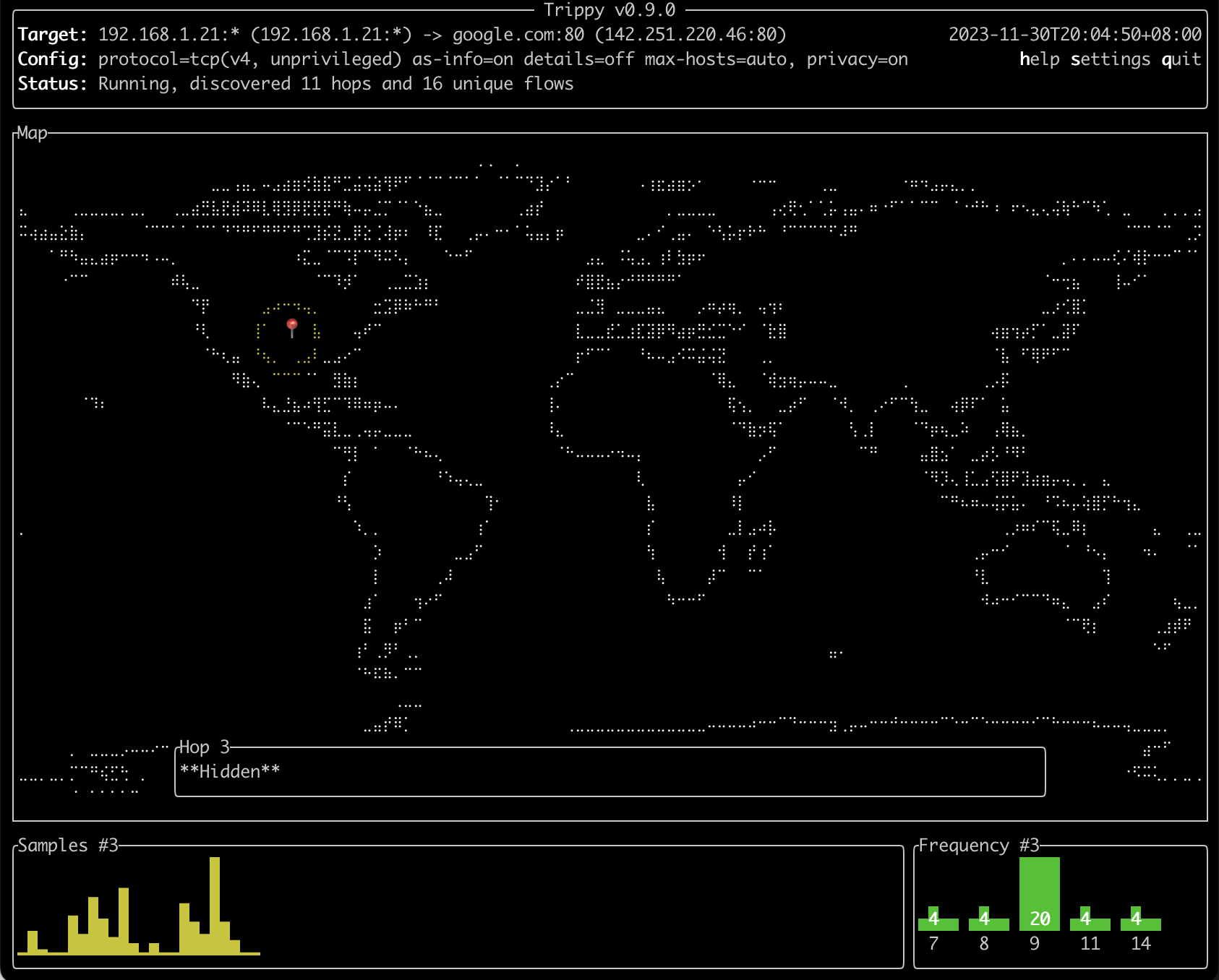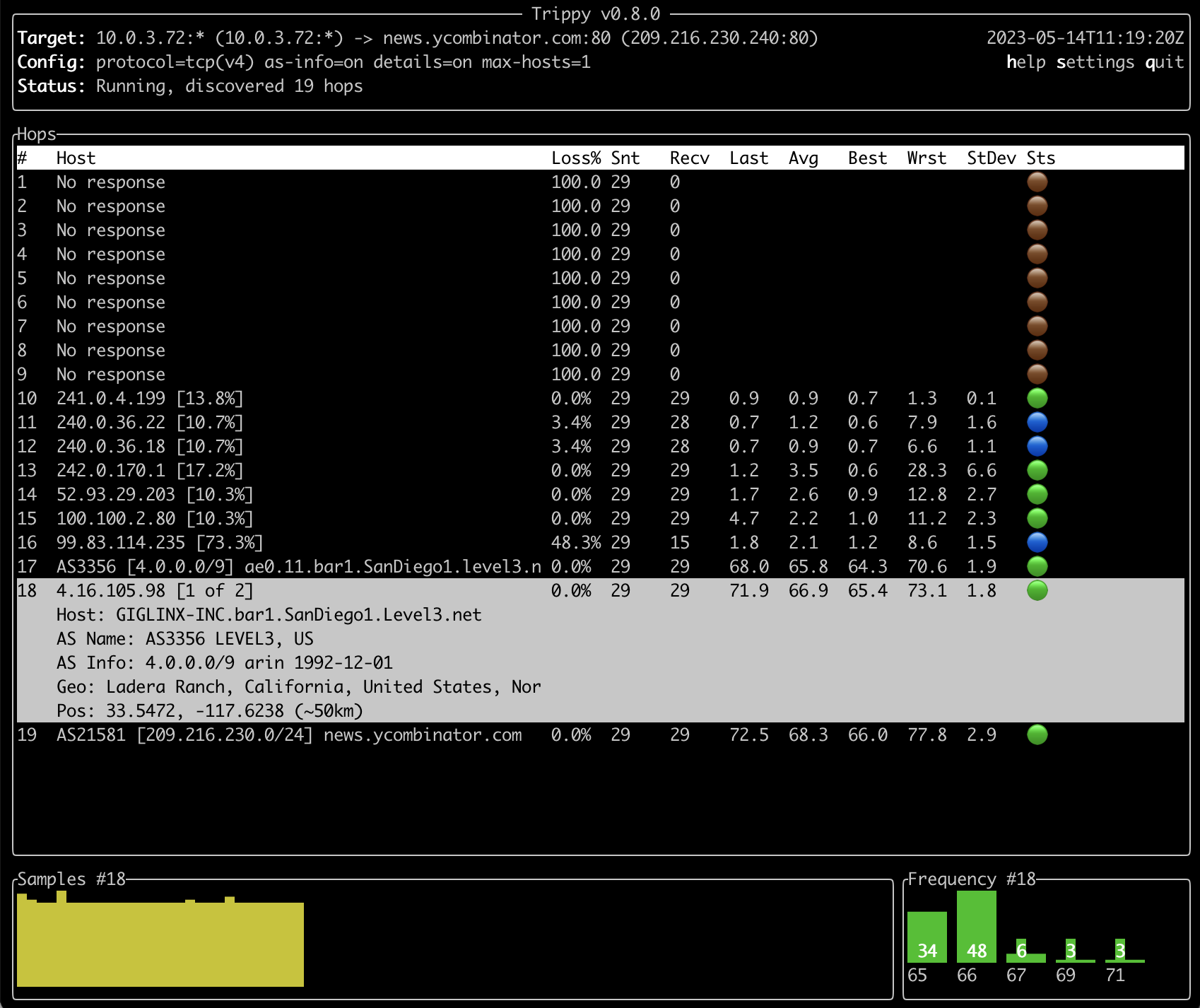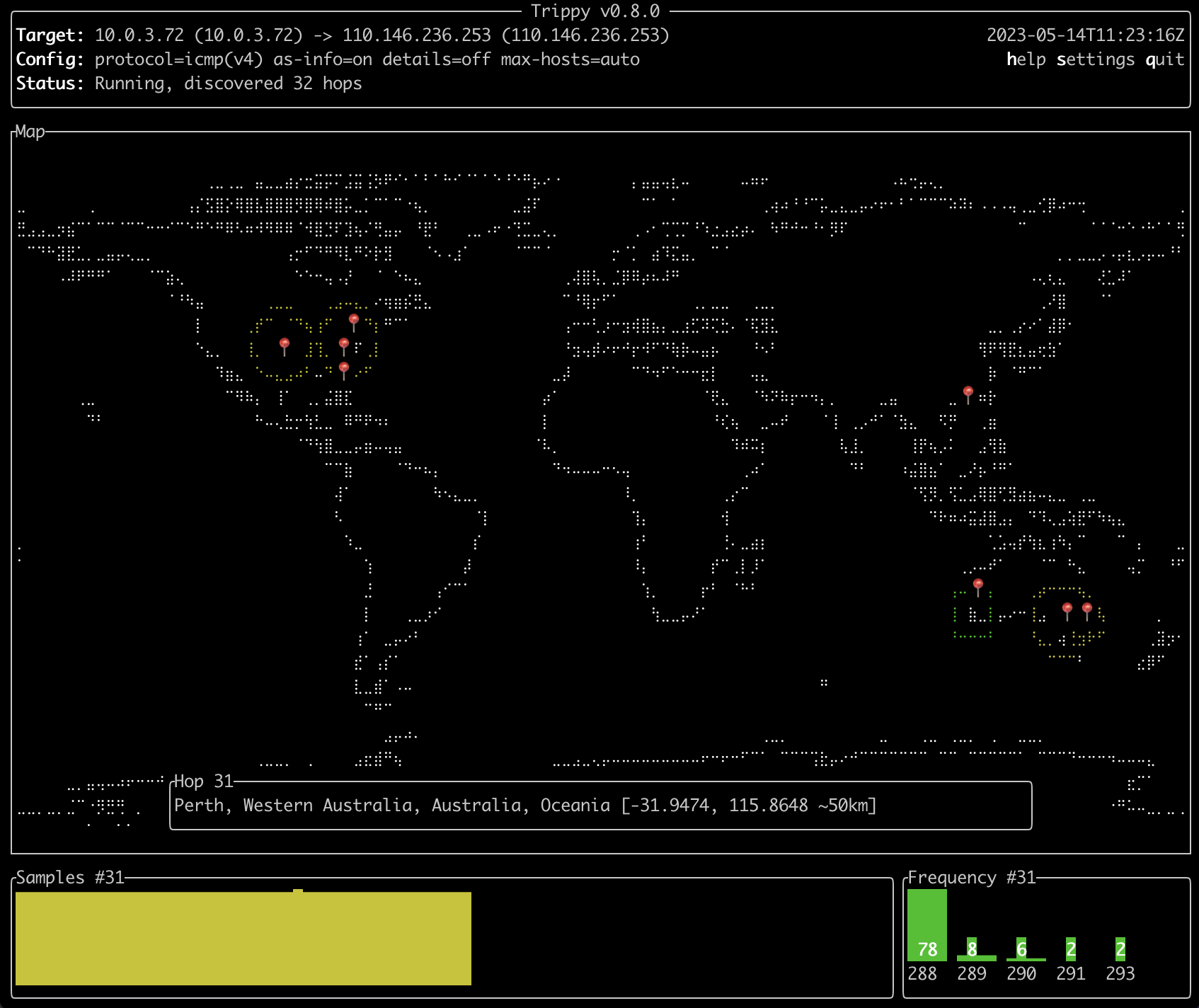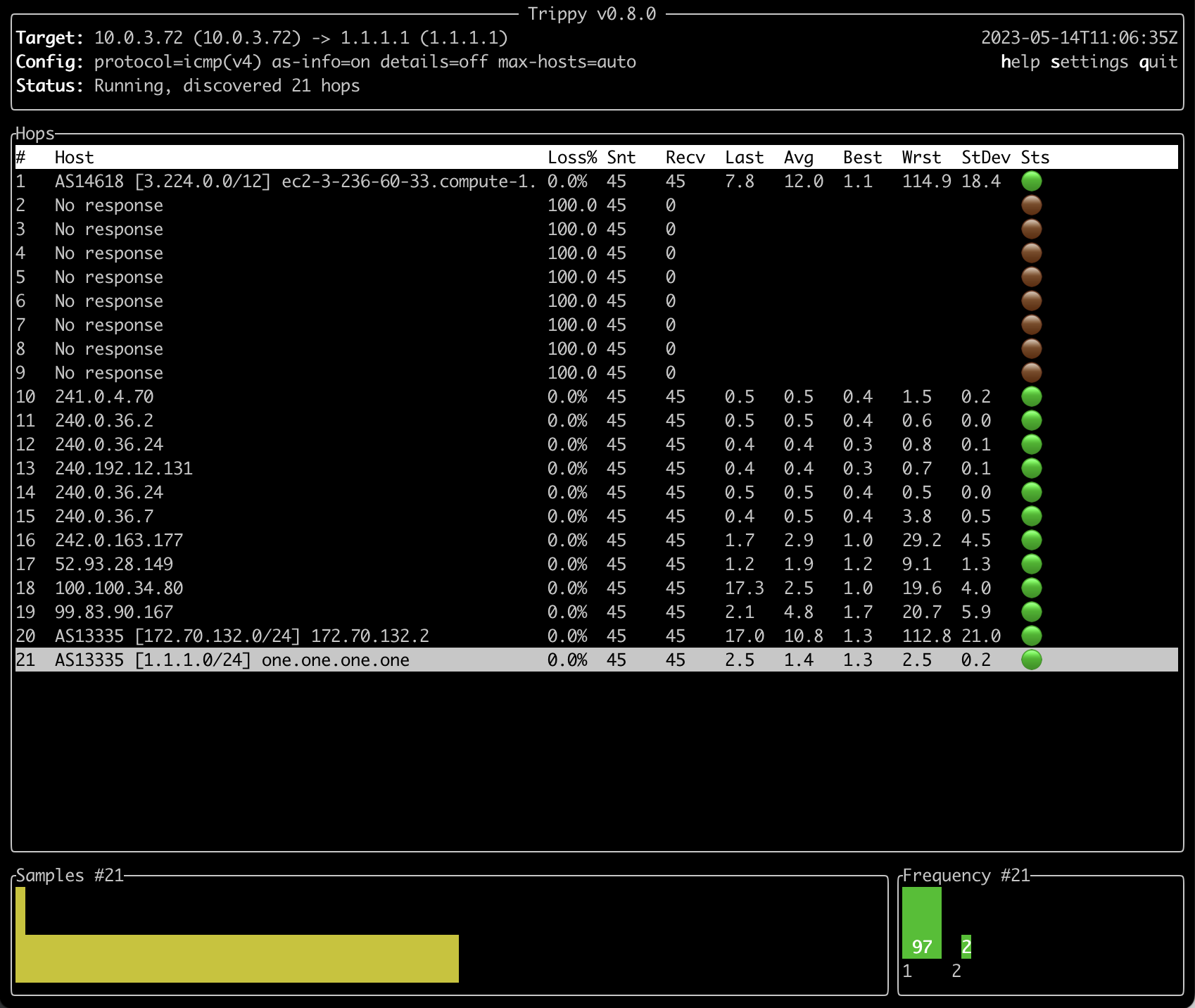Release notes for Trippy 0.6.0 onwards. See also the CHANGELOG.
This maintenance release of Trippy fixes a bug introduced in 0.12.0 which causes a tracer panic if --first-ttl is
set to be greater than one. The release also addresses a longstanding bug which causes --dns-resolve-method resolv to
ignore any value provided for --addr-family and therefore always use the default value of ipv4. Finally the help
text for --addr-family has been corrected.
See the main 0.12.0 release note.
This maintenance release of Trippy fixes a bug which prevented translations from working in Docker and also divests all
internal use of yaml dependencies which were problematic to maintain on some platforms (thanks to @nc7s).
See the main 0.12.0 release note.
The latest release of Trippy brings both cosmetic and functional improvements to the TUI, new columns, new distribution packages, and a number of bug fixes.
The TUI has been updated to include a new information bar at the bottom of the screen which allows for the header to be shortened and simplified. The sample history chart has been enhanced to highlight missing probes and the presentation of source and target addresses has also been simplified.
As well as these cosmetic changes, the TUI has gained support for internationalization (i18n) and the ability to adjust the hop privacy setting dynamically.
This release introduces three new columns, which provide novel heuristics for measuring forward loss and backward loss, that are designed to assist users in interpreting the status of the trace.
Finally, this update includes new distribution packages for Debian and Ubuntu and addresses a number of bugs.
The TUI now includes an information bar at the bottom of the screen, replacing the previous Config line in the
header. This change shortens the header by one line, optimizing space usage while keeping the overall vertical space of
the TUI unchanged.
The main TUI screen now appears as shown below (120x40 terminal size):
The left-hand side of the information bar displays a selection of static configuration items (in order):
- The address family and tracing protocol, e.g.,
IPv4/ICMP - The privilege level, either
privilegedorunprivileged - The locale, e.g., English (
en), French (fr), etc.
The right-hand side of the information bar displays a selection of adjustable configuration items (in order):
- A toggle controlling whether
ASNinformation is displayed (□ ASNfor disabled,■ ASNfor enabled) - A toggle controlling whether hop detail mode is enabled (
□ detailfor disabled,■ detailfor enabled) - A toggle controlling whether hostnames, IP addresses, or both are displayed (
host,ip, orboth) - The maximum
ttlvalue for hop privacy, shown as-(privacy disabled) or a number (0, 1, 2, etc.) - The maximum number of hosts displayed per hop, shown as
-(automatic) or a number (1, 2, etc.)
In the above screenshot, the information bar indicates the trace is using IPv4/ICMP, is running in privileged mode,
the locale is English (en), ASN information is displayed, hop detail mode is disabled, hostnames are displayed, the
hop privacy maximum ttl is 2, and the maximum number of hosts per hop is set to automatic.
Note: The information bar displays only a small number of important settings. All other settings can be viewed in the settings dialog, which can be opened by pressing
s(default key binding).
The theme colors of the information bar can be customized using the info-bar-bg-color and info-bar-text-color theme
items. Refer to the Theme Reference for more details.
Thanks to @c-git for their valuable feedback in refining the design of the information bar.
See #1349 for details.
Trippy displays a history of samples for each hop as a chart at the bottom of the TUI display. Each vertical line in the
chart corresponds to one sample, representing the value of the Last column.
Previously, if a probe was lost, the sample for that round would be shown as a blank vertical line. Starting with this release, Trippy now highlights lost probes using a full vertical line in red (default theme color), making them easier to identify.
The theme color for regular samples can be configured using the existing samples-chart-color configuration option.
Additionally, the theme color for lost probes can now be customized using the new samples-chart-lost-color
configuration option. For more details, see
the Theme Reference.
See #1247 for further details.
This release simplifies the display of the source and target addresses in the Target line in the header of the TUI.
The Target line has been updated such that, for both the source and destination addresses, the hostname is only shown
if it differs from the IP address.
For the destination address:
- If the user supplies a target hostname, it is resolved to an IP address, and both the IP address and the provided hostname are shown.
- If the user supplies an IP address, a reverse DNS hostname lookup is attempted. If successful, both the IP address and the first resolved hostname are shown; otherwise, only the IP address is displayed.
For the source address:
- A reverse DNS hostname lookup is attempted. If successful, both the IP address and the first resolved hostname are shown; otherwise, only the IP address is displayed.
For example, when the user supplies an IP address as the tracing target, the Target line in the header is now shown as
follows:
Target: 192.168.1.21 -> 93.184.215.14 (example.com)
See #1363 for details.
Trippy includes a privacy feature designed to hide sensitive information, such as IP addresses and GeoIP data, for all
hops up to a configurable maximum ttl via the tui-privacy-max-ttl configuration option.
Previously, the privacy feature could only be toggled on or off within the TUI using the toggle-privacy command and
only if tui-privacy-max-ttl was configured before Trippy was started.
In this release, the toggle-privacy command has been deprecated and replaced by two new TUI commands,
expand-privacy (bound to the p key by default) and contract-privacy (bound to the o key by default).
The expand-privacy command increases the tui-privacy-max-ttl value up to the maximum number of hops in the current
trace and the contract-privacy command decreases the tui-privacy-max-ttl value to the minimum value, which disables
privacy mode.
See #1347 for more details.
This release also repurposes the meaning of tui-privacy-max-ttl when set to 0. Previously, a value of 0 indicated
that no hops should be hidden. Starting from this release, a value of 0 will indicate that the source of the trace, as
shown in the Target line of the header, should be hidden.
Values of 1 or greater retain their existing behavior but will now also hide the source of the trace in addition to
the specified number of hops.
As a result of this change, the default value for tui-privacy-max-ttl has been updated:
- If not explicitly set (via a command-line argument or the configuration file), nothing will be hidden by default.
- If explicitly set to
0(the previous default), the source of the trace will be hidden.
See #1365 for details.
Trippy previously supported the --tui-preserve-screen command-line flag, which could be used to prevent the terminal
screen from being cleared when Trippy exits. This feature is useful for users who wish to review trace results after
exiting the application. However, the flag had to be set before starting Trippy and could not be toggled during a trace.
This release introduces the quit-preserve-screen TUI command (bound to the shift+q key by default). This command
allows users to quit Trippy without clearing the terminal screen, regardless of whether the --tui-preserve-screen flag
is set.
See #1382 for details.
The Trippy TUI has been translated into multiple languages. This includes all text displayed in the TUI across all screens and dialogs, as well as GeoIP location data shown on the world map.
The TUI will automatically detect the system locale and use the corresponding translations if available. The locale can
be overridden using the --tui-locale configuration option.
Locales can be specified for a language or a combination of language and region. For example a general locale can be
created for English (en) and specific regional locales can be created, such as United Kingdom English (en-UK) and
United States English (en-US).
If the user's chosen full locale (language-region) is not available, Trippy will fall back to using the locale for the
language only, if it exists. For example if the user sets the locale to en-AU, which is not currently defined in
Trippy, it will fall back to the en locale, which is defined.
If the user's chosen locale does not exist at all, Trippy will fall back to English (en).
Locales are generally added for the language only unless there is a specific need for region-based translations.
Some caveats to be aware of:
- The configuration file, command-line options, and most error messages are not translated.
- Many common abbreviated technical terms, such as
IPv4andASN, are not translated.
The following example sets the TUI locale to be Chinese (zh):
trip example.com --tui-locale zhThis can be made permanent by setting the tui-locale value in the tui section of the configuration file:
[tui]
tui-locale = "zh"The following screenshot shows the TUI with the locale set to Chinese (zh):
The list of available locales can be printed using the --print-locales flag:
trip --print-localesAs of this release, the following locales are available:
- Chinese (
zh) - English (
en) - French (
fr) - German (
de) - Italian (
it) - Portuguese (
pt) - Russian (
ru) - Spanish (
es) - Swedish (
sv) - Turkish (
tr)
See #1319, #1357, #1336 and the Locale Reference for more details.
Corrections to existing translations or the addition of new translations are always welcome. See the tracking issue for the status of each translation and details on how to contribute.
Adding these translations has been a significant effort and I would like to express a huge thank you (谢谢! Merci! Danke! Grazie! Obrigado! Спасибо! Gracias! Tack! Teşekkürler!) to @0323pin, @arda-guler, @histrio, @josueBarretogit, @one, @orhun, @peshay, @ricott1, @sxyazi, @ulissesf, and @zarkdav for all of their time and effort adding and reviewing translations for this release.
In line with most classic traceroute tools, Trippy displays the number of probes sent (Snd), received (Recv), and a
loss percentage (Loss%) for each hop. However, many routers are configured to rate-limit or even drop ICMP traffic.
This can lead to false positives for packet loss, particularly for intermediate hops, as the lack of a response from
such hops does not typically indicate genuine packet loss. This is a common source of confusion for users interpreting
trace results.
Trippy already provides a color-coded status column (Sts), that considers both packet loss percentage and whether the
hop is the target of the trace, to try and assist users in interpreting the status of each hop. While this feature is
helpful, it does not make it clear why a hop has a particular status nor help users interpret the overall status of
the trace.
To further assist users, this release of Trippy introduces a pair of novel heuristics to measure forward loss and backward loss. Informally, forward loss indicates whether the loss of a probe is the cause of subsequent losses and backward loss indicates whether the loss of a probe is the result of a prior loss on the path.
More precisely:
- forward loss for probe
Pin roundRoccurs when probePis lost in roundRand all subsequent probes within roundRare also lost. - backward loss for probe
Pin roundRoccurs when probePis lost in roundRand any prior probe within roundRhas forward loss.
These heuristics are encoded in three new columns:
Floss(F): The number of probes with forward lossBloss(B): The number of probes with backward lossFloss%(D): The percentage of probes with forward loss
These columns are hidden by default but can be enabled as needed. For more details, see the Column Reference.
The following screenshot shows an example trace with the new columns enabled:
In the following (contrived) example, after initially discovering the target (10.0.0.105) during the first round,
genuine packet loss occurs in all subsequent rounds at the third hop. This means that no probes on the common path are
able to get beyond the third hop.
╭Hops───────────────────────────────────────────────────────────────╮
│# Host Loss% Snd Recv Floss Bloss Floss% │
│1 10.0.0.101 0.0% 96 96 0 0 0.0% │
│2 10.0.0.102 0.0% 96 96 0 0 0.0% │
│3 No response 100.0% 96 0 95 0 98.9% │
│4 No response 100.0% 96 0 0 95 0.0% │
│5 10.0.0.105 99.0% 96 1 0 95 0.0% │
From this we can determine that the loss at the third hop is classified as forward loss because all subsequent probes (4th and 5th) in the same round are also lost. We can also conclude that the 4th and 5th hops have backward loss starting from round two, as in those rounds a prior hop (the third hop) has forward loss.
Note the difference between the traditional Loss% column and the new Floss% column. The Loss% column indicates
packet loss at several hops (3rd, 4th, and 5th). In contrast, the Floss% column helps us determine that the true
packet loss most likely occurs at the 3rd hop.
It is important to stress that this technique is a heuristic, and both false positives and false negatives are possible. Some specific caveats to be aware of include:
- Every probe sent in every round is an independent trial, meaning there is no guarantee that all probes within a given round will follow the same path (or "flow"). The concept of "forward loss" and "backward loss" assumes that all probes followed a single path. This assumption is typically met (but not guaranteed) when using tracing strategies such as ICMP, UDP/Dublin, or UDP/Paris.
- Any given host on the path may drop packets for only a subset of probes sent within a round, either due to rate
limiting or genuine intermittent packet loss. This could result in a false positive for "forward loss" at a given hop
if all subsequent hops in the round exhibit packet loss that is not genuine. For example, in the scenario above, the
hop with
ttl=3could be incorrectly deemed to have "forward loss" if observed loss from hopsttl=4andttl=5is not genuine (e.g., caused by rate-limiting). - A false positive for "backward loss" could occur at a hop experiencing genuine packet loss if a previous hop on the
path has "forward loss" that is not genuine. In the scenario above, if the hop with
ttl=4has genuine packet loss, it will still be marked with "backward loss" due to the "forward loss" atttl=3.
Despite these caveats, the addition of forward loss and backward loss heuristics aims to help users more accurately interpret trace outputs. However, these heuristics should be considered experimental and may be subject to change in future releases.
See #860 for details.
The previous release of Trippy introduced a bug (#1290) that
caused reverse DNS lookups to be enqueued multiple times when the dns-ttl expired, potentially leading to the hostname
being displayed as Timeout: xxx for a brief period.
A long-standing bug (#1398) which caused the TUI sample history and frequency charts to ignore sub-millisecond samples has been fixed.
This release fixes a bug (#1287) that caused the tracer to panic when parsing certain ICMP extensions with malformed lengths.
It also resolves an issue (#1289) where the ICMP extensions mode was not being displayed in the TUI settings dialog.
A bug (#1375) that caused the cursor to not move to the bottom of the screen when exiting while preserving the screen has also been fixed.
Finally, this release fixes a bug (#1327) that caused Trippy to
incorrectly reject the value ip for the tui-address-mode configuration option (thanks to @c-git).
Trippy is now available in Debian 13 (trixie) and later (with thanks to @nc7s!).
apt install trippySee (#1312) for details.
The official Trippy PPA for Ubuntu is now also available for the noble distribution.
sudo add-apt-repository ppa:fujiapple/trippy
sudo apt update && apt install trippySee (#1308) for details.
You can find the full list of distributions in the documentation.
My thanks to all Trippy contributors, package maintainers, translators and community members.
Feel free to drop by the Trippy Zulip room for a chat:
Happy Tracing!
This release of Trippy adds NAT detection for IPv4/UDP/Dublin tracing, a new public API, reverse DNS lookup cache time-to-live, transient error handling for IPv4, a new ROFF manual page generator, several new columns, improved error messages and a revamped help dialog with settings tab hotkeys.
There are two breaking changes, a new initial sequence number is used which impacts the default behavior of UDP tracing and two configuration fields have been renamed and moved.
Finally, there are a handful of bug fixes and two new distribution packages, Chocolatey for Windows and an official PPA for Ubuntu and Debian based distributions.
When tracing with the Dublin tracing strategy for IPv4/UDP, Trippy can now detect the presence of NAT (Network Address Translation) devices on the path.
RFC 3022 section 4.3 requires that "NAT to be completely transparent to the host" however in practice some fully compliant NAT devices leave behind a telltale sign that Trippy can use.
Trippy will indicate if a NAT device has been detected by adding [NAT] at the end of the hostname. There is also a
new (hidden by default) column, Nat, which can be enabled to show the NAT status per hop.
NAT devices are detected by observing a difference in the expected and actual checksum of the UDP packet that is returned as the part of the Original Datagram in the ICMP Time Exceeded message. If they differ then it indicates that a NAT device has modified the packet. This happens because the NAT device must recalculate the UDP checksum after modifying the packet (i.e. translating the source port) and so the checksum in the UDP packet that is nested in the ICMP error may not, depending on the device, match the original checksum.
To help illustrate the technique, consider sending the following IPv4/UDP packet (note the UDP Checksum B here):
+-+-+-+-+-+-+-+-+-+-+-+-+-+-+-+-+-+-+-+-+-+-+-+-+-+-+-+-+-+-+-+-+ │
|Version| IHL |Type of Service| Total Length | │
+-+-+-+-+-+-+-+-+-+-+-+-+-+-+-+-+-+-+-+-+-+-+-+-+-+-+-+-+-+-+-+-+ │
| Identification |Flags| Fragment Offset | │
+-+-+-+-+-+-+-+-+-+-+-+-+-+-+-+-+-+-+-+-+-+-+-+-+-+-+-+-+-+-+-+-+ │
| Time to Live | Protocol | Checksum A | │ IPv4 Header
+-+-+-+-+-+-+-+-+-+-+-+-+-+-+-+-+-+-+-+-+-+-+-+-+-+-+-+-+-+-+-+-+ │
| Source Address | │
+-+-+-+-+-+-+-+-+-+-+-+-+-+-+-+-+-+-+-+-+-+-+-+-+-+-+-+-+-+-+-+-+ │
| Destination Address | │
+-+-+-+-+-+-+-+-+-+-+-+-+-+-+-+-+-+-+-+-+-+-+-+-+-+-+-+-+-+-+-+-+ │
+-+-+-+-+-+-+-+-+-+-+-+-+-+-+-+-+-+-+-+-+-+-+-+-+-+-+-+-+-+-+-+-+ │
| Source Port | Destination Port | │
+-+-+-+-+-+-+-+-+-+-+-+-+-+-+-+-+-+-+-+-+-+-+-+-+-+-+-+-+-+-+-+-+ │ UDP Header
| Length | Checksum B | │
+-+-+-+-+-+-+-+-+-+-+-+-+-+-+-+-+-+-+-+-+-+-+-+-+-+-+-+-+-+-+-+-+ │
Trippy expect to receive an IPv4/ICMP TimeExceeded (or other) error which contains the Original Datagram (OD) IPv4/UDP
packet that was sent above with Checksum B' in the Original Datagram (OD) IPv4/UDP packet:
+-+-+-+-+-+-+-+-+-+-+-+-+-+-+-+-+-+-+-+-+-+-+-+-+-+-+-+-+-+-+-+-+ │
|Version| IHL |Type of Service| Total Length | │
+-+-+-+-+-+-+-+-+-+-+-+-+-+-+-+-+-+-+-+-+-+-+-+-+-+-+-+-+-+-+-+-+ │
| Identification |Flags| Fragment Offset | │
+-+-+-+-+-+-+-+-+-+-+-+-+-+-+-+-+-+-+-+-+-+-+-+-+-+-+-+-+-+-+-+-+ │
| Time to Live | Protocol | Checksum C | │ IPv4 Header
+-+-+-+-+-+-+-+-+-+-+-+-+-+-+-+-+-+-+-+-+-+-+-+-+-+-+-+-+-+-+-+-+ │
| Source Address | │
+-+-+-+-+-+-+-+-+-+-+-+-+-+-+-+-+-+-+-+-+-+-+-+-+-+-+-+-+-+-+-+-+ │
| Destination Address | │
+-+-+-+-+-+-+-+-+-+-+-+-+-+-+-+-+-+-+-+-+-+-+-+-+-+-+-+-+-+-+-+-+ │
+-+-+-+-+-+-+-+-+-+-+-+-+-+-+-+-+-+-+-+-+-+-+-+-+-+-+-+-+-+-+-+-+ │
| Type | Code | Checksum D | │
+-+-+-+-+-+-+-+-+-+-+-+-+-+-+-+-+-+-+-+-+-+-+-+-+-+-+-+-+-+-+-+-+ │ IPv4 Payload (ICMP TE Header)
| Unused | │
+-+-+-+-+-+-+-+-+-+-+-+-+-+-+-+-+-+-+-+-+-+-+-+-+-+-+-+-+-+-+-+-+ │
│
+-+-+-+-+-+-+-+-+-+-+-+-+-+-+-+-+-+-+-+-+-+-+-+-+-+-+-+-+-+-+-+-+ │ │
|Version| IHL |Type of Service| Total Length | │ │
+-+-+-+-+-+-+-+-+-+-+-+-+-+-+-+-+-+-+-+-+-+-+-+-+-+-+-+-+-+-+-+-+ │ │
| Identification |Flags| Fragment Offset | │ │
+-+-+-+-+-+-+-+-+-+-+-+-+-+-+-+-+-+-+-+-+-+-+-+-+-+-+-+-+-+-+-+-+ │ │
| Time to Live | Protocol | Checksum A' | │ │ ICMP TE Payload (OD IPv4 Header)
+-+-+-+-+-+-+-+-+-+-+-+-+-+-+-+-+-+-+-+-+-+-+-+-+-+-+-+-+-+-+-+-+ │ │
| Source Address | │ │
+-+-+-+-+-+-+-+-+-+-+-+-+-+-+-+-+-+-+-+-+-+-+-+-+-+-+-+-+-+-+-+-+ │ │
| Destination Address | │ │
+-+-+-+-+-+-+-+-+-+-+-+-+-+-+-+-+-+-+-+-+-+-+-+-+-+-+-+-+-+-+-+-+ │ │
│ │
+-+-+-+-+-+-+-+-+-+-+-+-+-+-+-+-+-+-+-+-+-+-+-+-+-+-+-+-+-+-+-+-+ │ │ │
| Source Port | Destination Port | │ │ │
+-+-+-+-+-+-+-+-+-+-+-+-+-+-+-+-+-+-+-+-+-+-+-+-+-+-+-+-+-+-+-+-+ │ │ │ OD IPv4 Payload (UDP header)
| Length | Checksum B' | │ │ │
+-+-+-+-+-+-+-+-+-+-+-+-+-+-+-+-+-+-+-+-+-+-+-+-+-+-+-+-+-+-+-+-+ │ │ │
If Checksum B' in the UDP packet nested in the ICMP error does not match Checksum B in the UDP packet that was sent
then Trippy can infer that a NAT device is present.
This technique allows for the detection of NAT at the first hop. To detect multiple NAT devices along the path, Trippy must also check for changes in the observed checksum between consecutive hops, as changes to the UDP checksum will " carry forward" to subsequent hops. This requires taking care to account for hops that do not respond. This is only possible when using the Dublin tracing strategy, as it does not modify the UDP header per probe; therefore, the checksums are expected to remain constant, allowing changes in the checksum between hops to be detected.
Note that this method cannot detect all types of NAT devices and so should be used in conjunction with other methods where possible.
See the issue for more details.
Trippy has been designed primarily as a standalone tool, however it is built on top of a number of useful libraries, such as the core tracer, DNS resolver and more. These libraries have always existed but were tightly integrated into the tool and were not designed for use by third party crates.
This release introduces the Trippy public API which can be used to build custom tools on top of the Trippy libraries.
The full set of libraries exposed is:
| Crate | Description |
|---|---|
| trippy | Common entrypoint crate |
| trippy-core | The core Trippy tracing functionality |
| trippy-packet | Packet wire formats and packet parsing functionality |
| trippy-dns | Perform forward and reverse lazy DNS resolution |
| trippy-privilege | Discover platform privileges |
| trippy-tui | The Trippy terminal user interface |
To use the Trippy public API you should add the common entrypoint trippy crate to your Cargo.toml file and then
enable the desired features. Note that the trippy crate includes tui as a default feature and so you should disable
default features when using it as a library. Alternatively, it is also possible to add the crates individually.
For example, to use the core Trippy tracing functionality you would add the trippy crate, disable default features and
enable the core feature:
[dependencies]
trippy = { version = "0.11.0", default-features = false, features = ["core"] }The hello-world example below demonstrates how to use the Trippy public API to perform a simple trace and print the
results of each round:
use std::str::FromStr;
use trippy::core::Builder;
fn main() -> anyhow::Result<()> {
let addr = std::net::IpAddr::from_str("1.1.1.1")?;
Builder::new(addr)
.build()?
.run_with(|round| println!("{:?}", round))?;
Ok(())
}Whilst Trippy adheres to Semantic Versioning, the public API is not yet considered stable and may change in future releases.
See crates and the usage examples for more information.
For UDP tracing, by default, Trippy uses a fixed source port and a variable destination port which is set from the sequence number, starting from an initial sequence of 33000 and incremented for each probe, eventually wrapping around.
By convention, many devices on the internet allow UDP
probes to ports in the range 33434..=33534 and will return a DestinationUnreachable ICMP error, which can be used to
confirm that the target has been reached. Since Trippy does not use destination ports in this range for UDP probes by
default, the target host will typically not respond with an ICMP error, and so Trippy cannot know that the target was
reached, and must therefore show the hop as unknown.
Another issue with this default setup is that the sequence number will eventually enter the range 33434..=33534 at which
point the target will begin to respond with the DestinationUnreachable ICMP error. However, there is no guarantee
that the probe sent for sequence 33434 (i.e., the first one for which the target host will be able to respond) will be
for the minimum time-to-live (ttl) required to reach the target. This leads to confusing output, which is hard for users
to interpret. See issue for more details.
These issues can be avoided today, either by changing the initial sequence number to be in the range 33434..=33534 by
setting the --initial-sequence flag or by using a fixed destination port (and therefore a variable source port) in the
same range by setting the --target-port flag.
In the following example, the initial sequence number is set to 33434:
trip example.com --udp --initial-sequence 33434This can be made permanent by setting the initial-sequence value in the strategy section of the configuration file:
[strategy]
initial-sequence = 33434In the following example, the destination port is set to 33434:
trip example.com --udp --target-port 33434This can be made permanent by setting the target-port value in the strategy section of the configuration file:
[strategy]
target-port = 33434As the default behavior in Trippy leads to these confusing issues, this release modifies the default sequence number to be 33434. This is a breaking change and will impact users who rely on the old default initial sequence number.
This change introduces a new problem, albeit a lesser one: UDP traces will now begin with a destination port of 33434
and so DestinationUnreachable ICMP errors will typically be returned by the target immediately. However, eventually
the sequence number will move beyond the range 33434..=33534 and so the target host will stop responding
with DestinationUnreachable ICMP errors. This leads to the appearance that the target has started dropping packets.
While this is technically correct, this is not desirable behavior as the target has not really disappeared.
It is therefore recommended to always fix the target-port to be in the range 33434..=33534 for UDP tracing and allow
the source port to vary instead. This may become the default behavior for UDP tracing in a future release; that would
represent a significant difference in default behavior compared to most traditional Unix traceroute tools, which vary
the destination port by default.
Trippy performs a reverse DNS lookup for each host encountered during the trace and the resulting hostnames are cached indefinitely. This can lead to stale hostnames being displayed in the TUI if they change after the trace has begun.
Note that the DNS cache can be flushed manually by pressing ctrl+k (default key binding) in the TUI.
Starting from this release, the reverse DNS cache can be configured to expire after a certain time to live. By default
this is set to be 5 minutes (300 seconds) and can be configured using the --dns-ttl flag or the dns-ttl
configuration option.
The following example sets the DNS cache time-to-live to 30 seconds:
trip example.com --dns-ttl 30sThis can be made permanent by setting the dns-ttl value in the dns section of the configuration file:
[dns]
dns-ttl = "30s"Trippy records the number of probes sent and the number of probes received for each hop and uses this information to calculate packet loss. Any probe that is successfully sent for which no response is received is considered lost.
Currently, if a probe cannot be sent for any reason, then Trippy will crash and show a BSOD. This is not typically an issue, as such failures imply a local issue with the host network configuration rather than an issue with the target or any intermediate hops.
However, it is possible that a probe may fail to send for a transient reason, such as a temporary local host issue, and so it would be useful to be able to handle such errors gracefully. A common example would be running Trippy on a host and during the trace disabling the network interface.
Starting from this release, Trippy will continue the trace even if a probe fails to send and will instead show a warning
to the user in the TUI about the number of probe failures. A new column (hidden by default), Fail, has also been added
to the TUI to show the number of probes that failed to send for each hop.
This has been implemented for macOS, Linux and Windows for IPv4 only. Support for IPv6 and other platforms will be added in future releases.
See the tracking issue for more details.
Trippy can now generate manual pages in ROFF format. This can be useful for users who wish to install Trippy on systems which do not have a package manager or for users who wish to install Trippy from source. It can also be used by package maintainers to generate manual pages for their distribution.
The following command generates a ROFF manual page for Trippy:
trip --generate-man > /path/to/man/pages/trip.1This release introduced several new columns, all of which are hidden by default. These are:
Type: The ICMP packet type for the last probe for the hopCode: The ICMP packet code for the last probe for the hopNat: The NAT detection status for the hopFail: The number of probes which failed to send for the hop
The following shows the Type and Code columns:
See the Column Reference for a full list of all available columns.
The settings dialog can be accessed by pressing s (default key binding) and users can navigate between the tabs using
the left and right arrow keys (default key bindings). This release introduces hotkeys to allow users to jump directly to
a specific tab by pressing 1-7 (default key bindings).
See the Key Bindings Reference for details.
The existing Trippy help dialog shows a hardcoded list of key bindings which may not reflect the actual key bindings the
user has configured. Trippy shows the correct key bindings in the settings dialog which can be accessed by
pressing s (default key binding) and navigating to the Bindings tab. Therefore, the key bindings in the help dialog
are both potentially incorrect and redundant.
This release revamps the help dialog and includes instructions on how to access the key bindings from the settings dialog as well as some other useful information.
Error reporting has been improved for parameters such as --min-round-duration (-i). Previously, if an invalid
duration was provided, the following error would be reported:
$ trip example.com -i 0.05
Error: invalid character at 1Starting from this release, such error will instead be shown as:
$ trip example.com -i 0.05
error: invalid value '0.05' for '--min-round-duration <MIN_ROUND_DURATION>': expected time unit (i.e. 100ms, 2s, 1000us)
For more information, try '--help'.This covers all "duration" parameters, namely:
min_round_durationmax_round_durationgrace_durationread_timeoutdns_timeouttui_refresh_rate
The following configuration fields have been renamed and moved from the [tui] to the [strategy] section in the
configuration file:
tui-max-samples->max-samplestui-max-flows->max-flows
This is a breaking change. Attempting to use the legacy field names will result in an error pointing to the new name.
The following example shows the error reported if the old names are used from the command line:
error: unexpected argument '--tui-max-samples' found
tip: a similar argument exists: '--max-samples'The following examples shows the error reported if the ld names are used from the configuration file:
Error: tui-max-samples in [tui] section is deprecated, use max-samples in [strategy] section insteadThis release fixes a bug where DestinationUnreachable ICMP errors were assumed to have been sent by the target host,
whereas they may also be sent by an intermediate hop.
Another fix addresses an issue where the TUI would calculate the maximum number of hops to display based on the maximum observed across all rounds rather than for the latest round.
Finally, a minor bug was fixed where AddressInUse and AddrNotAvailable errors were being conflated.
Trippy has been added to the Chocolatey community repository (with thanks to @Aurocosh!):
choco install trippyTrippy also has an official PPA for Ubuntu and Debian based distributions (with thanks to @zarkdav!):
sudo add-apt-repository ppa:fujiapple/trippy
sudo apt update && apt install trippyYou can find the full list of distributions in the documentation.
My thanks to all Trippy contributors, package maintainers and community members.
Feel free to drop by the new Trippy Zulip room for a chat:
Happy Tracing!
The first release of 2024 is packed with new features, such as customizable columns, jitter calculations, Dublin tracing strategy for IPv6/UDP, support for IPinfo GeoIp files, enhanced DNS resolution with IPv6/IPv4 fallback and CSS named colors for the TUI as well as a number of bug fixes. Since the last release there has also been a significant improvement in automated testing, notably the introduction of TUN based simulation testing for IPv4.
It is now possible to customize which columns are shown in the TUI and to adjust the order in which they are displayed. This customization can be made from within the TUI or via configuration.
To customize the columns from the TUI you must open the settings dialog (s key) and navigating to the new Columns
tab (left and right arrow keys). From this tab you can select the desired column (up and down arrow keys) and toggle the
column visibility on and off (c key) or move it left (, key) or right (. key) in the list of columns.
You can supply the full list of columns, in the desired order, using the new --tui-custom-columns command line
argument. The following example specifies the standard list of columns in the default order:
trip example.com --tui-custom-columns holsravbwdtAlternatively, to make the changes permanent you may add the tui-custom-columns entry to the tui section of the
Trippy configuration file:
[tui]
tui-custom-columns = "holsravbwdt"Note that the value of tui-custom-columns can be seen in the corresponding field of the Tui tab of the settings
dialog and will reflect any changes made to the column order and visibility via the Tui. This can be useful as you may
copy this value and use it in the configuration file directly.
This release also introduced several new columns, all of which are hidden by default. These are:
- Last source port: The source port for last probe for the hop
- Last destination port: The destination port for last probe for the hop
- Last sequence number: The sequence number for the last probe for the hop
- Jitter columns: see the "Calculate and Display Jitter" section below
See the Column Reference for a full list of all available columns.
The column layout algorithm used in the hop table has been improved to allow the maximum possible space for the Host
column. The width of the Host column is now calculated dynamically based on the terminal width and the set of columns
currently configured.
Trippy can now calculate and display a variety of measurements related to jitter for each hop. Jitter is a measurement
of the difference in round trip time between consecutive probes. Specifically, the following new calculated values are
available in Trippy 0.10.0:
- Jitter: The round-trip-time (RTT) difference between consecutive rounds for the hop
- Average Jitter: The average jitter of all probes for the hop
- Maximum Jitter: The maximum jitter of all probes for the hop
- Inter-arrival Jitter: The smoothed jitter value of all probes for the hop
These values are always calculated and are included in the json report. These may also be displayed as columns in the
TUI, however they are not shown by default. To enabled these columns in the TUI, please see
the Column Reference.
The addition of support for the dublin tracing strategy for IPv6/UDP marks the completion of a multi-release journey to provide support for both Dublin and paris tracing strategies for both IPv4/UDP and IPv6/UDP.
As a reminder, unlike classic traceroute and MTR, these alternative tracing strategies do not encode the probe sequence number in either the src or dest port of the UDP packet, but instead use other protocol and address family specific techniques. Specifically, the Dublin tracing strategy for IPv6/UDP varies the length of the UDP payload for this purpose.
By doing so, these strategies are able to keep the src and dest ports fixed which makes it much more likely (though not guaranteed) that each round of tracing will follow the same path through the network (note that this is not true for the return path).
The following command runs an IPv6/UDP trace using the Dublin tracing strategy with fixed src and dest ports:
trip example.com --udp -6 -R dublin -S 5000 -P 3500Note that, for both Paris and Dublin tracing strategies, if you fix either the src or dest ports (but not both) then
Trippy will vary the unfixed port per round rather than per hop. This has the effect that all probes within a
round will likely follow the same network path but probes between round will follow different paths. This can be
useful in conjunction with flows (f key) to visualize the various paths packet flow through the network. See
this issue for more details.
With UDP support for the Paris and Dublin tracing strategies now complete, what remains is adding support for these for the TCP protocol. Refer to the ECMP tracking issue for details.
Trippy currently supports the ability to lookup and display GeoIp information from MMDB files, but prior to 0.10.0
only the MaxMind "GeoLite2 City" (and lite) MMDB files were supported. This release
introduces support for the "IP to Country + ASN Database" and "IP to Geolocation Extended Database" MMDB files
from IPinfo.
The "IP to Country + ASN Database" MMDB file provided by IPinfo can be used as follows:
trip example.com --geoip-mmdb-file /path/to/country_asn.mmdb --tui-geoip-mode shortThese settings can be made permanent by setting the following values in the tui section of the configuration file:
[tui]
geoip-mmdb-file = "/path/to/country_asn.mmdb"
tui-geoip-mode = "short"When provided with a DNS name such as example.com Trippy tries to resolve it to an IPv4 or an IPv6 address and fails
if no such IP exists for the configured addr-family mode, which must be either IPv4 or IPv6.
Starting from version 0.10.0, Trippy can be configured to support ipv4-then-ipv6 and ipv6-then-ipv4 modes
for addr-family. In the new ipv4-then-ipv6 mode Trippy will first attempt to resolve the given hostname to an IPv4
address and, if no such address exists, it will attempt to resolve to an IPv6 address and only fail if neither are
available (and the opposite for the new ipv6-then-ipv4 mode). The addr-family mode may also be set to be ipv4
or ipv6 for IPv4 only and IPv6 only respectively.
To set the addr-family to be IPv6 with fallback to IPv4 you can set the --addr-family command line parameter:
trip example.com --addr-family ipv6-then-ipv4To make the change permanent you can set the addr-family value in the strategy section of the configuration file:
[strategy]
addr-family = "ipv6-then-ipv4"Note that Trippy supports both the addr-family entry in the configuration file and also the --ipv4 (-4)
and --ipv6 (-6) command line flags, all of which are optional. The command line flags (which are mutually exclusive)
take precedence over the config file entry and if neither are provided there it defaults to ipv4-then-ipv6.
Trippy allows the theme to be customized and supports the named ANSI colors:
Black, Red, Green, Yellow, Blue, Magenta, Cyan, Gray, DarkGray, LightRed, LightGreen, LightYellow, LightBlue, LightMagenta, LightCyan, White
The 0.10.0 release adds support for CSS named colors (
e.g. SkyBlue). Note that these are only supported on some platforms and terminals and may not render correctly
elsewhere.
See the Theme Reference
Manually testing all Trippy features in all modes and on all supported platforms is an increasingly time consuming and error prone activity. Since the last release a significant effort has been made to increase the testing coverage, including unit and integration testing.
In particular, the introduction of simulation testing allows for full end-to-end testing of all modes and features on Linux, macOS and Windows without the need to mock or stub any behaviour within Trippy.
This is achieved by creating a TUN device to simulate the behavior of network nodes, responding to various pre-configured scenarios like packet loss and out-of-order arrivals.
Whilst not a change that directly benefits end users, this new testing approach should reduce the effort needed to test each release of Trippy and help improve the overall reliability of the tool.
Note that the simulation testing is currently only supported for IPv4. See the Integration Testing tracking issue for more details.
My thanks to all Trippy contributors, package maintainers and community members.
Feel free to drop by the Trippy Matrix room for a chat:
Happy Tracing!
Trippy 0.9.0 introduces many new features, including tracing flows and ICMP extensions, the expansion of support for
the Paris tracing strategy to encompass IPv6/UDP, an unprivileged execution mode for macOS, a hop privacy mode and many
more. Additionally, this release includes several important bug fixes along with a range of new distribution packages.
A tracing flow represents the sequence of hosts traversed from the source to the target. Trippy is now able to identify individual flows within a trace and assign each a unique flow id. Trippy calculate a flow id for each round of tracing, based on the sequence of hosts which responded during that round, taking care to account for rounds in which only a subset of hosts responded. Tracing statistics, such as packet loss % and average RTT are recorded on a per-flow basis as well as being aggregated across all flow.
Tracing flows adds to the existing capabilities provided by Trippy to assist
with ECMP (Equal-Cost Multi-Path Routing) when tracing
with UDP and TCP protocols. Some of these capabilities, such as
the paris
and dublin tracing strategies, are designed to restrict tracing
to a single flow, whilst others, such as the hop detail navigation mode (introduce in the last release) and tracing
flows, are designed to help visualize tracing data in the presence of multiple flows. See
the 0.8.0 release note for other such capabilities.
The TUI has been enhanced with a new mode to help visualise flows. This can be toggled on and off with
the toggle-flows command (bound to the f key by default).
When toggled on, this mode display flow information as a chart in a new panel above the hops table. Flows can be selected by using the left and right arrow keys (default key bindings). Flows are sorted by the number of rounds in which a given flow id was observed, with the most frequent flow ids shown on the left. When entering this mode flow id 1 is selected automatically. The selected flow acts as a filter for the other parts of the TUI, including the hops table, chart and maps views which only show data relevant to that specific flow.
When toggled off, Trippy behaves as it did in previous versions where aggregated statistics (across all flows) are shown. Note that per-flow data is always recorded, the toggle only influences how the data is displayed.
The number of flows visible in the TUI is limited and can be controlled by the tui-max-flows configuration items which
can be set via the command line or via the configuration file. By default up to 64 flows are shown.
The flows panel, as with all other parts of the TUI, can also be themed, see the theme reference for details.
As well as visualising flows in the TUI, Trippy 0.9.0 introduces two new reports which make use of the tracing flow
data.
The new flows report mode records and print all flows observed during tracing.
The following command will run a TCP trace for 10 round and report all of the flows observed:
trip example.com --tcp -m flows -C 10Sample output (truncated) showing three unique flows:
flow 1: 192.168.1.1, 10.193.232.245, 218.102.40.38, 10.195.41.9, 172.217.27.14
flow 2: 192.168.1.1, 10.193.232.245, 218.102.40.22, 10.195.41.17, 172.217.27.14
flow 3: 192.168.1.1, 10.193.232.245, 218.102.40.38, 10.195.41.1, 172.217.27.14
Another new report, dot, outputs a GraphViz DOT
format chart of all hosts observed during tracing.
The following command will run a TCP trace for 10 round and output a graph of flows in DOT format:
trip example.com --tcp -m dot -C 10If you have a tool such as dot (Graphviz) installed you can use this to rendered the output in various formats, such
as PNG:
trip example.com --tcp -m dot -C 10 | dot -Tpng > path.pngSample output:
Trippy 0.9.0 adds the ability to parse and display ICMP Multi-Part Messages (aka extensions). It supports both
compliant and non-compliant ICMP extensions as defined
in section 5 of rfc4884.
Trippy is able to parse and render any generic Extension Object but is also able to parse some well known Object Classes, notably the MPLS class.
Support for additional classes will be added to future versions of Trippy, see the ICMP Extensions tracking issue.
Parsing of ICMP extensions can be enabled by setting the --icmp-extensions (-e) command line flag or by adding
the icmp-extensions entry in the strategy section of the configuration file:
[strategy]
icmp-extensions = trueThe TUI has been enhanced to display ICMP extensions in both the normal and hop detail navigation modes.
In normal mode, ICMP extensions are not shown by default but can be enabled by setting the --tui-icmp-extension-mode
command line flag or by adding the tui-icmp-extension-mode entry in the tui section of the configuration file:
[tui]
tui-icmp-extension-mode = "full"This can be set to off (do not show ICMP extension data), mpls (shows a list of MPLS label(s) per hop), full (
shows all details of all extensions, such as ttl, exp and bos for MPLS) or all (the same as full but also
shows class, subtype and bytes for unknown extension objects).
The following screenshot shows ICMP extensions in normal mode with tui-icmp-extension-mode set to be mpls:
In hop detail mode, the full details of all ICMP extension objects are always shown if parsing of ICMP extensions is enabled.
The following screenshot shows ICMP extensions in hop detail mode:
ICMP extension information is also included the json and stream report modes.
Sample output for a single hop from the json report:
{
"ttl": 14,
"hosts": [
{
"ip": "129.250.3.125",
"hostname": "ae-4.r25.sttlwa01.us.bb.gin.ntt.net"
}
],
"extensions": [
{
"mpls": {
"members": [
{
"label": 91106,
"exp": 0,
"bos": 1,
"ttl": 1
}
]
}
}
],
"loss_pct": "0.00",
"sent": 1,
"last": "178.16",
"recv": 1,
"avg": "178.16",
"best": "178.16",
"worst": "178.16",
"stddev": "0.00"
}The work to support the remaining paris and dublin tracing modes continues in this release with the addition of support for the Paris tracing strategy for IPv6/UDP.
As a reminder, unlike classic traceroute and MTR, these alternative tracing strategies do not encode the probe sequence number in either the src or dest port of the UDP or TCP packet, but instead use other protocol and address family specific techniques. Specifically, the Paris tracing strategy for IPv6/UDP utilizes the UDP checksum for this purposes and manipulates the UDP payload to ensure packets remind valid.
By doing so, these strategies are able to keep the src and dest ports fixed which makes it much more likely (though not guaranteed) that each round of tracing will follow the same path through the network (note that this is not true for the return path).
The following command runs a IPv6/UDP trace using the paris tracing strategy with fixed src and dest ports:
trip example.com --udp -6 -R paris -S 5000 -P 3500Refer to the tracking issue for details of the work remaining to support all ECMP strategies for both UDP and TCP for IPv4 and IPv6.
Trippy normally requires elevated privileges due to the use of raw sockets. Enabling the required privileges for a given platform can be achieved in several ways as in described the privileges section of the documentation.
This release of Trippy adds the ability to run without elevated privileged on a subset of platforms, but with some limitations which are described below.
The unprivileged mode can be enabled by adding the --unprivileged (-u) command line flag or by adding
the unprivileged entry in the trippy section of the configuration file:
[trippy]
unprivileged = trueThe following command runs a trace in unprivileged mode:
trip example.com -uUnprivileged mode is currently only supported on macOS. Linux support is possible and may be added in the future.
Unprivileged mode is not supported on NetBSD, OpenBSD, FreeBSD or Windows as these platforms do not support
the IPPROTO_ICMP socket type.
Unprivileged mode does not support the paris or dublin tracing strategies as these require raw sockets in order to
manipulate the UDP and IP header respectively.
See #101 for further information.
Trippy can be provided with either an IP address or a hostname as the target for tracing. Trippy will resolve hostnames
to IP addresses via DNS lookup (using the configured DNS resolver, see the existing --dns-resolve-method flag) and
pick an arbitrary IP address from those returned.
Trippy also has the ability to trace to several targets simultaneously (for the ICMP protocol only) and can be provided with a list of IP addresses and hostnames.
Trippy 0.9.0 combined these features and introduces a convenience flag --dns-resolve-all which resolves a given
hostname to all IP addresses and will begin to trace to all of them simultaneously.
At times it is desirable to share tracing information with others to help with diagnostics of a network problem. These traces can contain sensitive information, such as IP addresses, hostnames and GeoIp details of the internet facing hops. Users often wish to avoid exposing this data and are forced to redact the tracing output or screenshots.
Trippy 0.9.0 adds a new privacy feature, which hides all sensitive information for a configurable number of hops in
the hops table, chart and GeoIP world map.
The following screenshot shows the world map view with the sensitive information of some hops hidden:
The following command will hide all sensitive information for the first 3 hops (ttl 1, 2 & 3) in the TUI:
trip example.com --tui-privacy-max-ttl 3This can also be made the default behaviour by setting the value in the Trippy configuration file:
[tui]
tui-privacy-max-ttl = 3From within the TUI the privacy mode can be toggled on and off using the toggle-privacy TUI command (bound to the p
key by default).
Note the toggle is only available if tui-privacy-max-ttl is configured to be non-zero. Privacy mode is entered
automatically on startup to avoid any accidental exposure of sensitive data, such as when sharing a screen.
The 0.8.0 release of Trippy introduced
a configuration file and provided a sample
configuration file you could download. This release adds a command which generates a configuration template appropriate
for the specific version of Trippy.
The following command generates a trippy.toml configuration file with all possible configuration options specified and
set to their default values:
trip --print-config-template > trippy.tomlCan't decide whether you want to use h or ? to display help information? Well fear not, Trippy now supports
an toggle-help-alt TUI command (bound to the ? key by default) in additional to the existing toggle-help TUI
command (bound to the h key by default).
This release fixes a bug that prevented reverse DNS lookup from working in all reporting modes.
The list of IPs associated with a given hop have also been added to the csv and all tabular reports. ICMP extension
data has also been included in several reports.
Note that these are breaking change as the output of the reports has changed.
The list of operating systems, CPU architectures and environments which have pre-build binary assets available for
download has been greatly expanded for the 0.9.0 release.
This includes assets for Linux, macOS, Windows, NetBSD and FreeBSD. Assets are available for x86_64, aarch64
and arm7 and includes builds for various environments such as gnu and musl where appropriate. There are also
pre-build RPM and deb downloads available. See
the Binary Asset Download section for a full list.
Note that Trippy 0.9.0 has only been tested on a small subset of
these platforms.
Since the last release Trippy has been added as an official WinGet package (kudos to @mdanish-kh and @BrandonWanHuanSheng!) and can be installed as follows:
winget install trippyTrippy has also been added to the scoop Main bucket (thanks to @StarsbySea!) and can be installed as follows:
scoop install trippyYou can find the full list of distributions in the documentation.
My thanks to all Trippy contributors, package maintainers and community members.
Feel free to drop by the Trippy Matrix room for a chat:
Happy Tracing!
The 0.8.0 release of Trippy brings several new features, UX enhancements, and quality of life improvements, as well as
various small fixes and other minor improvements.
Trippy offers various mechanisms to visualize ECMP ( Equal-Cost Multi-Path Routing) when tracing with UDP and TCP protocols. Features include displaying all hosts for a given hop in a scrollable table, limiting the number of hosts shown per hop (showing the % of traffic for each host), and greying out hops that are not part of a specific tracing round.
Despite these helpful features, visualizing a complete trace can be challenging when there are numerous hosts for some hops, which is common in environments where ECMP is heavily utilized.
This release enhances ECMP visualization support by introducing a hop detail navigation mode, which can be toggled on
and off by pressing d (default key binding). This mode displays multiline information for the selected hop only,
including IP, hostname, AS, and GeoIP details about a single host for the hop. Users can navigate forward and backward
between hosts in a given hop by pressing , and . (default key bindings), respectively.
In addition to visualizing ECMP, Trippy also supports alternative tracing strategies to assist with ECMP routing, which are described below.
Trippy already supports both classic and dublin tracing strategies, and this release adds support for the paris tracing strategy for the UDP protocol.
Unlike classic traceroute and MTR, these alternative tracing strategies do not encode the probe sequence number in either the src or dest port of the UDP or TCP packet, but instead use other protocol and address family specific techniques.
This means that every probe in a trace can share common values for the src & dest hosts and ports which, when combined with the protocol, is typically what is used to making traffic route decisions in ECMP routing. This means that these alternative tracing strategies significantly increase the likelihood that the same path is followed for each probe in a trace (but not the return path!) in the presence of ECMP routing.
The following command runs a UDP trace using the new paris tracing strategy with fixed src and dest ports (the src and
dest hosts and the protocol are always fixed) and will therefore likely follow a common path for each probe in the
trace:
trip www.example.com --udp -R paris -S 5000 -P 3500Future Trippy versions will build upon these strategies and further improve the ability to control and visualize ECMP routing, refer to the tracking issue for further details.
Trippy now supports the ability to look up and display GeoIP information from a user-provided MaxMind GeoLite2 City database. This information is displayed per host in the hop table (for both normal and new detail navigation modes) and can be shown in various formats. For example, short form like "San Jose, CA, US" or long form like "San Jose, California, United States, North America," or latitude, longitude, and accuracy radius like "37.3512, -121.8846 (~20km)".
The following command enables GeoIP lookup from the provided GeoLite2-City.mmdb file and will show long form locations
in the hop table:
trip example.com --geoip-mmdb-file GeoLite2-City.mmdb --tui-geoip-mode longAdditionally, Trippy features a new interactive map screen that can be toggled on and off by pressing m (default key
binding). This screen displays a world map and plots the location of all hosts for all hops in the current trace, as
well as highlighting the location of the selected hop.
Trippy has long offered the ability to look up and display AS information. This release makes this feature more flexible by allowing different AS details to be shown in the hops table, including AS number, AS name, prefix CIDR, and registry details.
The following command enables AS lookup and will display the prefix CIDR for each host in the TUI:
trip example.com -z true -r resolv --tui-as-mode prefixThis release also fixes a limitation in earlier versions of Trippy that prevented the lookup of AS information for IP
addresses without a corresponding PTR DNS record.
The number of configurable parameters in Trippy has grown significantly, surpassing the number that can be comfortably displayed in the TUI header section. Previous Trippy versions displayed an arbitrarily chosen subset of these parameters, many of which have limited value for users and consume valuable screen space.
This release introduces a new interactive settings dialog that can be toggled on and off with s (default key binding)
to display all configured parameters. The TUI header has also been cleaned up to show only the most relevant
information, specifically the protocol and address family, the AS info toggle, the hop details toggle, and the max-hosts
setting.
The previous Trippy release introduced the ability to customize the TUI color theme and key bindings, both of which could be specified by command-line arguments. While functional, this method is inconvenient when configuring a large number of colors or keys.
This release adds support for a Trippy configuration file, allowing for persistent storage of color themes, key bindings, and all other configuration items supported by Trippy.
For a sample configuration file showing all possible configurable items that are available, see the configuration reference for details.
This release enables the generation of shell completions for various shells, including bash, zsh, PowerShell, and fish,
using the new --generate command-line flag.
The following command will generate and store shell completions for the fish shell:
trip --generate fish > ~/.config/fish/completions/trip.fishThis release adds a number of command-line flags to enable debug logging, enhancing the ability to diagnose failures.
For example, the following command can be used to run tracing with no output, except for debug output in a format
suitable to be displayed with chrome://tracing or similar tools:
trip www.example.com -m silent -v --log-format chromeSocket errors have also been augmented with contextual information, such as the socket address for a bind failure, to help with the diagnosis of issues.
Trippy is now also available as a Nix package (@figsoda), a FreeBSD port (@ehaupt) and a Windows Scoop package. This
release also re-enables support for a musl binary which was disabled in 0.7.0 due to a bug in a critical library
used by Trippy.
See distributions for the full list of available packages.
My thanks, as ever, to all Trippy contributors!
- @utkarshgupta137 made their first contribution in #537
The major highlight of the 0.7.0 release of Trippy is the addition of full support for Windows, for all tracing modes and protocols! 🎉. This has been many months in the making and is thanks to the hard work and perseverance of @zarkdav.
This release also sees the introduction of custom Tui themes and key bindings, deb and rpm package releases, as well
as several important bug fixes.
My thanks to all the contributors!
The first official release of Trippy!
